
Dish, Henry Piercy, Alexandria, ca. 1792–1796. Slipware. D. 10". (All objects courtesy Alexandria Archaeology unless otherwise noted; photos by Gavin Ashworth unless otherwise noted.)
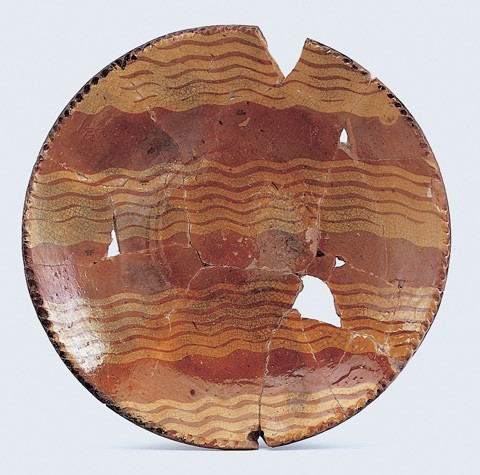
Dish, Topham/Miller Pottery, Philadelphia, ca. 1795–1815. Slipware. D. 13 1/2". (Courtesy, Dr. Richard J. Dent, Department of Anthropology, American University.)
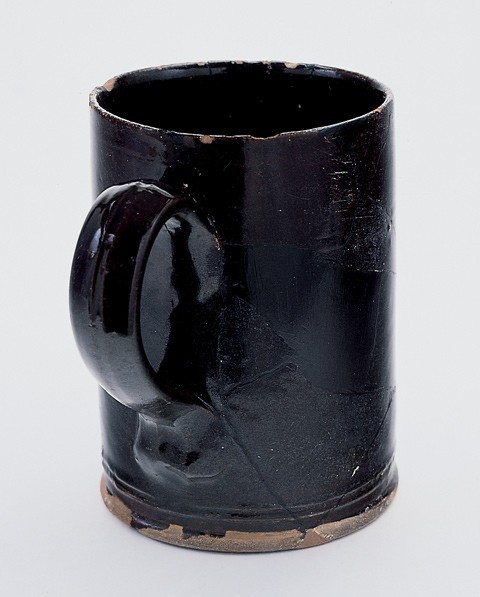
Tankard, Henry Piercy, Alexandria, ca. 1792–1795. Lead-glazed earthenware. H. 6 1/4".
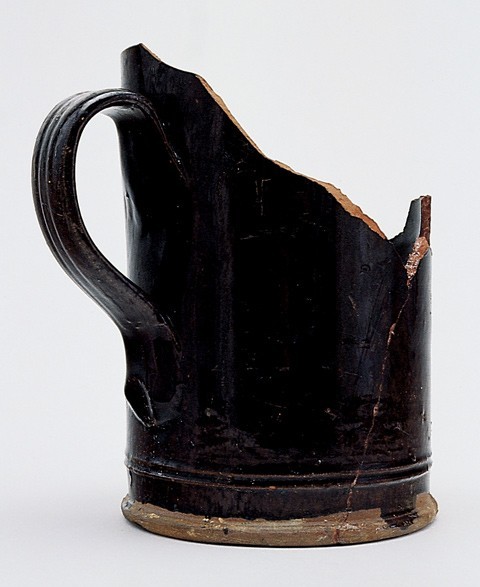
Tankard, Philadelphia, ca. 1770s. Lead-glazed earthenware. H. 6 1/4". (Courtesy, National Park Service, Independence National Historical Park, Inde-57732.)
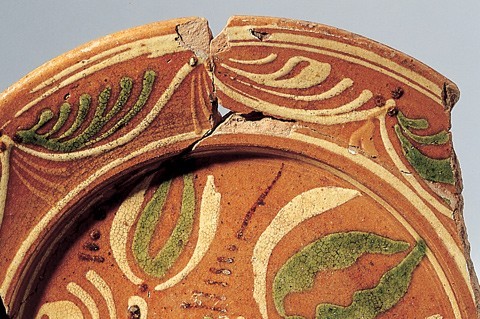
Dish, Philadelphia, ca. 1769. Slipware. D. 9". (Courtesy, National Park Service, Independence National Historical Park, Franklin Court V-627.) This Moravian-style vessel, with a multicolored slip-trailed tulip design, shows a strong Germanic influence.
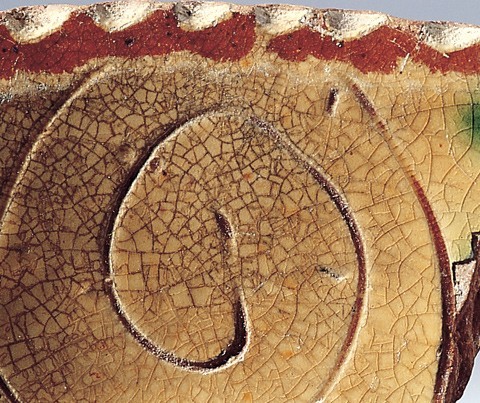
Dish, Philadelphia, ca. 1769. Slipware. D. 8 3/4". (Courtesy, National Park Service, Independence National Historical Park, Inde-24523.) The sgrafitto technique of scratching a design through a layer of slip was commonly used in England.
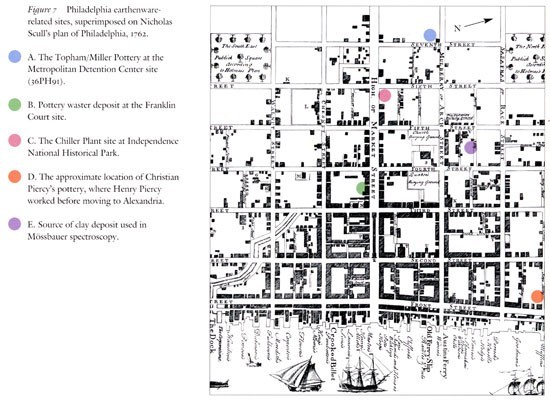
Philadelphia earthenware- related sites, superimposed on nicholas Scull's plan of Philadelphia, 1762.
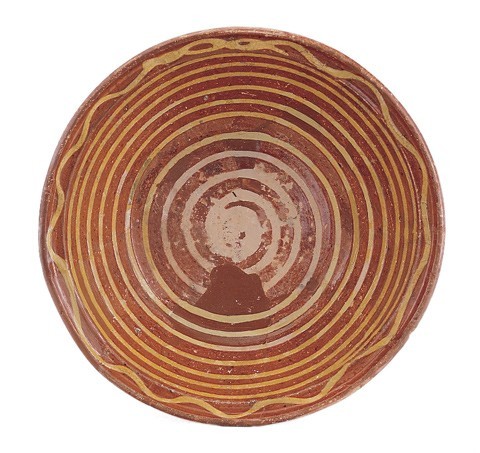
Pans, Henry Piercy, Alexandria, ca. 1792–1796. Slipware. D. 11 3/4", 12 1/2" and 12 3/4". These vessels were found in a privy behind a china and glass shop that Henry Piercy owned from 1795 to 1796.

Pans, Henry Piercy, Alexandria, ca. 1792–1796. Slipware. D. 11 3/4", 12 1/2" and 12 3/4". These vessels were found in a privy behind a china and glass shop that Henry Piercy owned from 1795 to 1796.
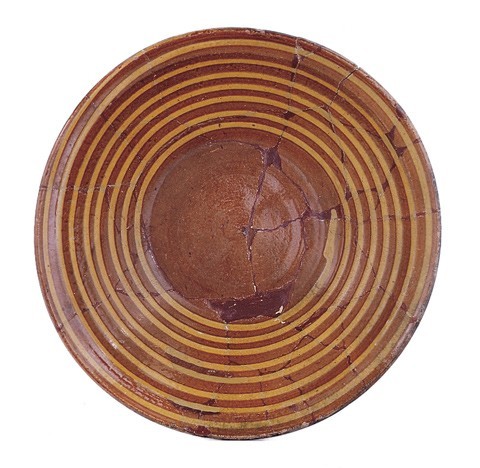
Pans, Henry Piercy, Alexandria, ca. 1792–1796. Slipware. D. 11 3/4", 12 1/2" and 12 3/4". These vessels were found in a privy behind a china and glass shop that Henry Piercy owned from 1795 to 1796.
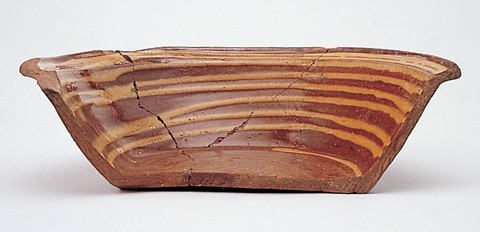
Pans, Philadelphia, ca. 1770–1815. Slipware. D. 11 3/4", 9", 7 3/4" (Courtesy, National Park Service, Independence National Historical Park, Inde-23683, Inde-57278; and Dr. Richard J. Dent, Department of Anthropology, American University.)

Pans, Philadelphia, ca. 1770–1815. Slipware. D. 11 3/4", 9", 7 3/4" (Courtesy, National Park Service, Independence National Historical Park, Inde-23683, Inde-57278; and Dr. Richard J. Dent, Department of Anthropology, American University.)

Pans, Philadelphia, ca. 1770–1815. Slipware. D. 11 3/4", 9", 7 3/4" (Courtesy, National Park Service, Independence National Historical Park, Inde-23683, Inde-57278; and Dr. Richard J. Dent, Department of Anthropology, American University.)

Detail of pans showing slip-trailed spiral decoration. (Courtesy, Alexandria Archaeology; and National Park Service, Independence National Historical Park, Inde-57278.) The example on the left, from the Piercy kiln site, shows the even, finely executed spirals found on Alexandria slipware. The example on the right is from Philadelphia, ca. 1770s.
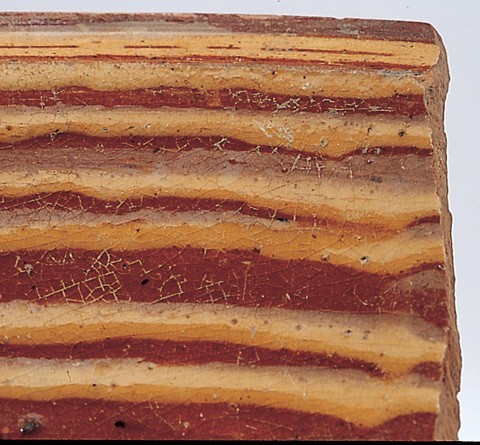
Detail of pans showing slip-trailed spiral decoration. (Courtesy, Alexandria Archaeology; and National Park Service, Independence National Historical Park, Inde-57278.) The example on the left, from the Piercy kiln site, shows the even, finely executed spirals found on Alexandria slipware. The example on the right is from Philadelphia, ca. 1770s.
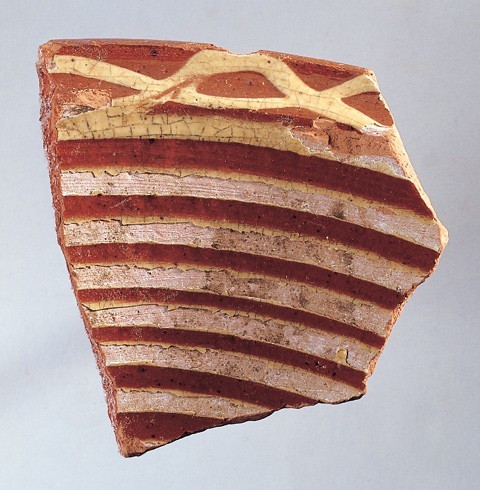
Pan fragment, Henry Piercy, Alexandria, 1792–1809. Slipware. This rim from the Piercy waster dump is embellished with a chain pattern made of two intersecting lines of slip. A plain line or single wavy line is more common.
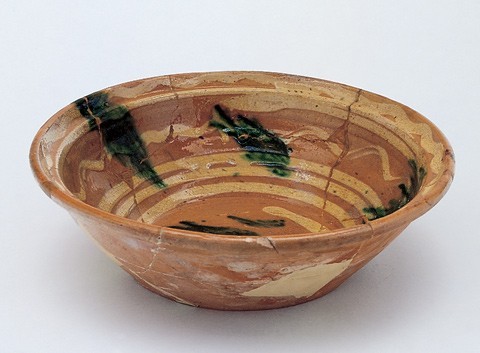
Pan, Alexandria, ca. 1792– 1809. D. 10 1/4". Slipware with green copper-oxide splotches.
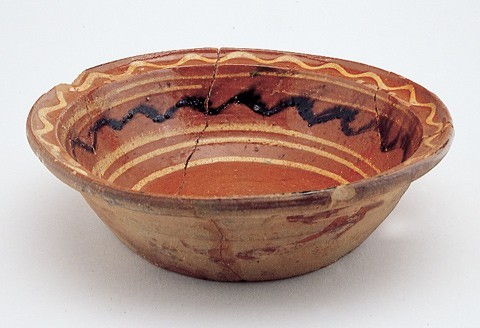
Pan, Philadelphia, ca. 1770s. Slipware with black and yellow trailed slip. D. 8 1/2". (Courtesy, National Park Service, Independence National Historical Park, Inde-57209.) Similar black slip is used by Shenandoah Valley potters, but not in Alexandria.

Chargers, Henry Piercy, Alexandria, ca. 1792–1796. Slipware. D. 13", 12 1/2", 13". These large dishes were among more than eighty of Piercy’s manufacture that were found in a privy behind his King Street retail shop, occupied for only six months from 1795 to 1796.
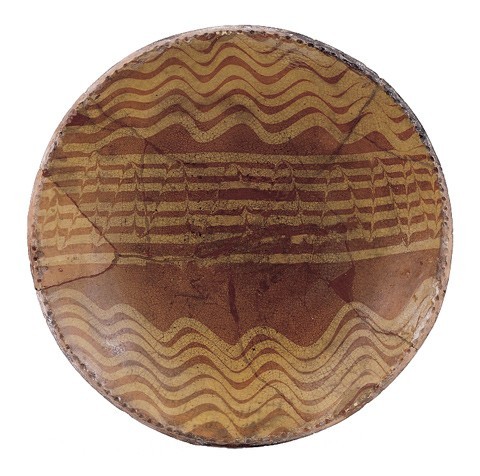
Chargers, Henry Piercy, Alexandria, ca. 1792–1796. Slipware. D. 13", 12 1/2", 13". These large dishes were among more than eighty of Piercy’s manufacture that were found in a privy behind his King Street retail shop, occupied for only six months from 1795 to 1796.
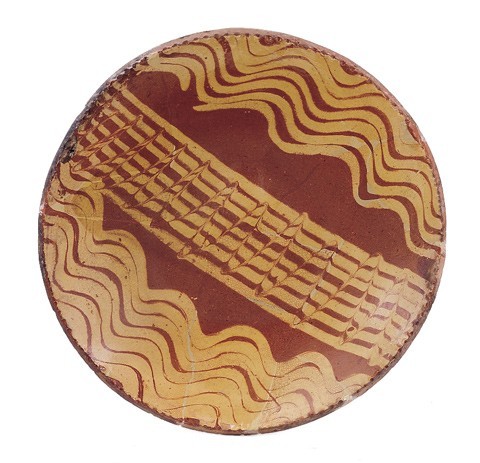
Chargers, Henry Piercy, Alexandria, ca. 1792–1796. Slipware. D. 13", 12 1/2", 13". These large dishes were among more than eighty of Piercy’s manufacture that were found in a privy behind his King Street retail shop, occupied for only six months from 1795 to 1796.
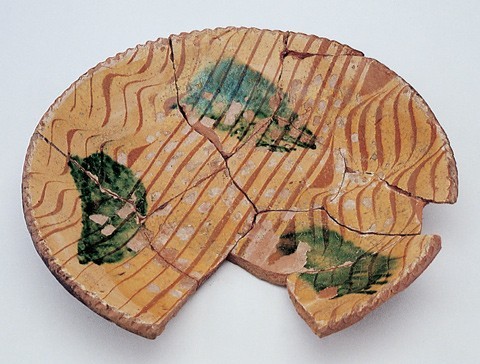
Chargers, Philadelphia, ca. 1770s. Slipware with green copper-oxide daubings. D. 11 3/4" and 9 1/2". (Courtesy, National Park Service, Independence National Historical Park, Inde-57214 and Franklin Court V-279.)
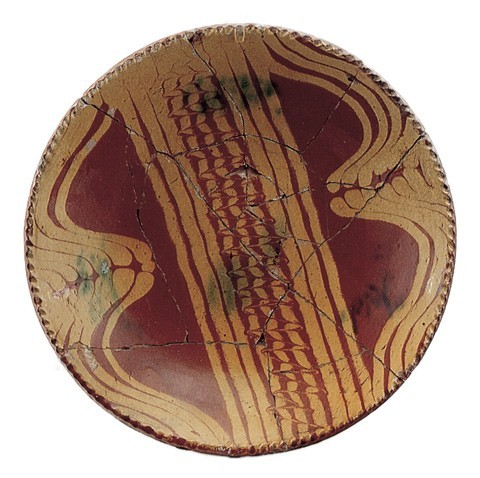
Chargers, Philadelphia, ca. 1770s. Slipware with green copper-oxide daubings. D. 11 3/4" and 9 1/2". (Courtesy, National Park Service, Independence National Historical Park, Inde-57214 and Franklin Court V-279.)
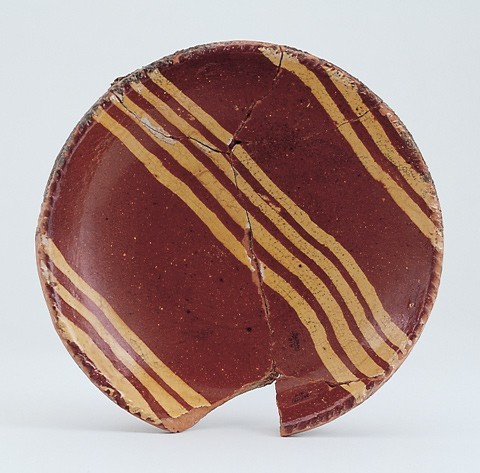
Dish, Topham/Miller Pottery, Philadelphia, ca. 1795–1815. Slipware. D. 7 1/2". (Courtesy Dr. Richard J. Dent, Department of Anthropology, American University.) A faint circle from the drape mold can be seen in the center.
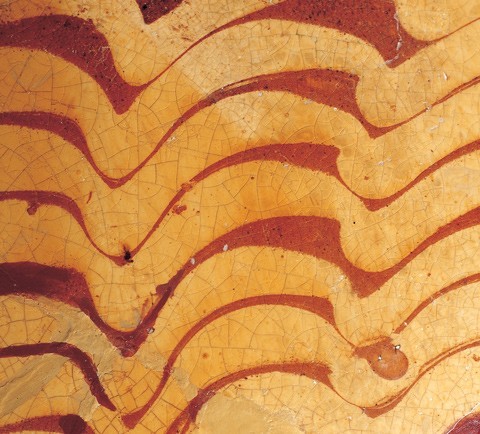
Detail of a dish, Henry Piercy, Alexandria, 1792–1796. This dish clearly shows the use of a multiple-spouted slip cup.
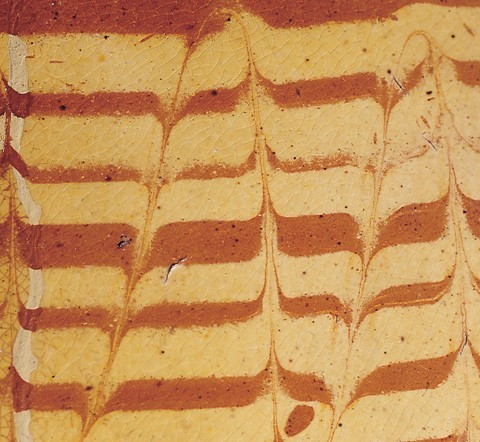
Detail of the combed slip on a dish from the Henry Piercy site, Alexandria, 1792–1796.

Dish fragment, Henry Piercy, Alexandria, 1792–1809. Slipware. This sherd from the Piercy kiln site is decorated with combed slip and copper-oxide splotches.

Dish, Henry Piercy, Alexandria, 1792–1796. Slipware. D. 10".
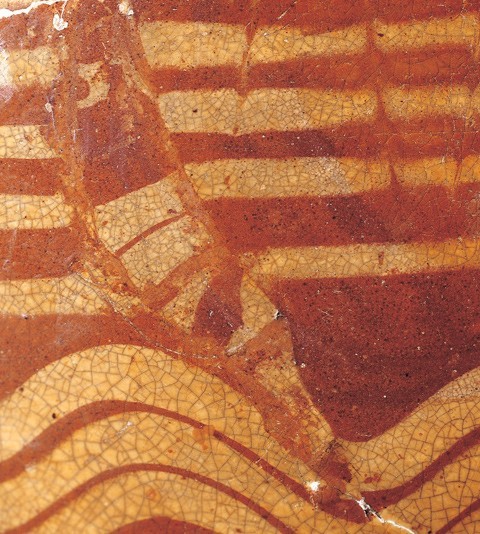
Detail of the dish illustrated in fig. 20, showing a repair made at the time of manufacture. Small areas of slip were damaged when the dish was removed from the drape mold. Repairs were made using mismatched fragments of slip decoration, which may have been trimmed from the edge of the dish.

Bowls, Henry Piercy, Alexandria, ca. 1792–1796. Slipware. D. 5 1/2", 6", 5". Note the variation in slip decoration.
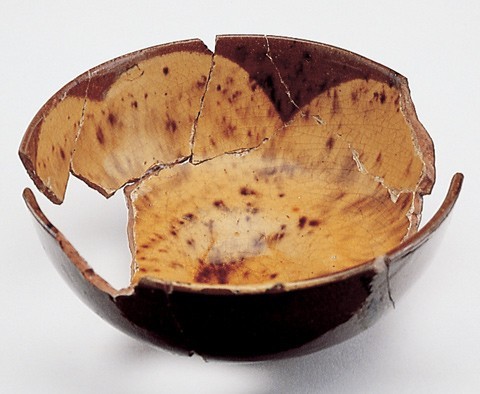
Bowls, Philadelphia, ca. 1770–1815. Slipware. D. 6 1/4", 5 1/4", 6". (Courtesy National Park Service, Independence National Historical Park, Inde-54233 and Inde-60183; and Dr. Richard J. Dent, Department of Anthropology, American University.) The application of the slip in lobes, or “petals,” can be clearly seen on the example from Franklin Court (left).

Bowls, Philadelphia, ca. 1770–1815. Slipware. D. 6 1/4", 5 1/4", 6". (Courtesy National Park Service, Independence National Historical Park, Inde-54233 and Inde-60183; and Dr. Richard J. Dent, Department of Anthropology, American University.) The application of the slip in lobes, or “petals,” can be clearly seen on the example from Franklin Court (left).

Bowls, Philadelphia, ca. 1770–1815. Slipware. D. 6 1/4", 5 1/4", 6". (Courtesy National Park Service, Independence National Historical Park, Inde-54233 and Inde-60183; and Dr. Richard J. Dent, Department of Anthropology, American University.) The application of the slip in lobes, or “petals,” can be clearly seen on the example from Franklin Court (left).

Sherds of narrow-mouthed vessels, Henry Piercy, Alexandria, ca. 1792–1809. Lead-glazed earthenware. Wheel marks seen on the interior surface indicate that these sherds, from the Piercy kiln site, come from narrow-mouthed vessels such as jugs and pitchers. The potter smoothed the interior of wide-mouthed bowls, porringers, and chamber pots.
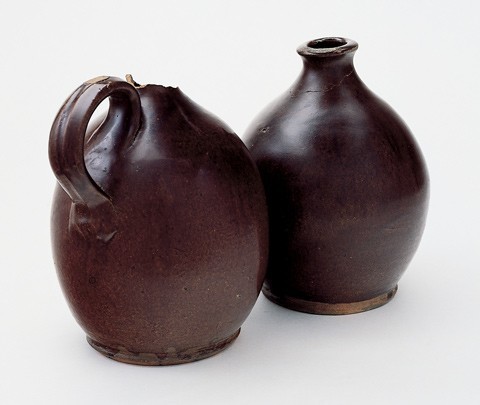
Syrup jugs, Henry Piercy, Alexandria, ca. 1792–1796. Lead-glazed earthenware. H. 7". These examples are from the site of Piercy’s shop.
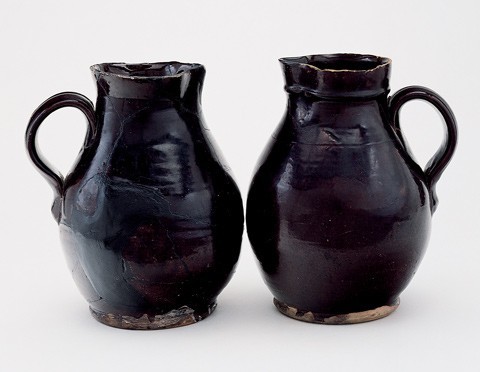
Pitchers, Henry Piercy, Alexandria, ca. 1792–1796. Lead-glazed earthenware. H. 9". Both styles are also found in Philadelphia. These examples are also from the site of Piercy’s shop.

Chamber pot, Henry Piercy, Alexandria, ca. 1792–1796. Lead-glazed earthenware. D. 7 1/2".
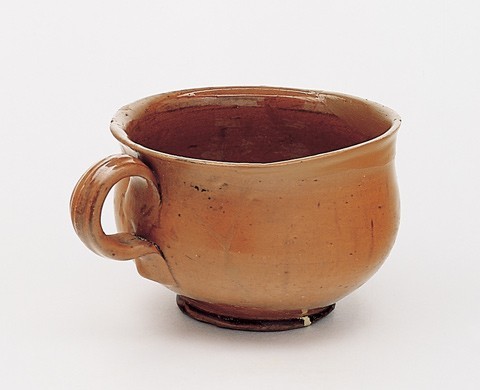
Porringer, Henry Piercy, Alexandria, ca. 1792–1796. Lead-glazed earthenware. D. 5 1/2".
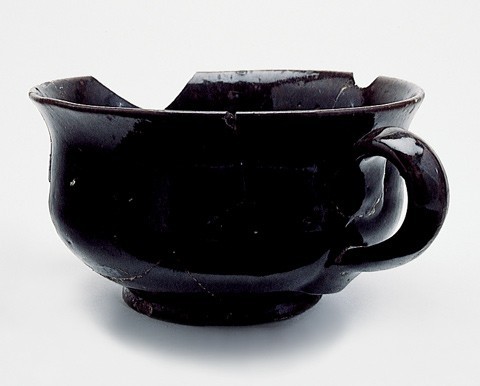
Porringer, Philadelphia, ca. 1769. Lead-glazed earthenware. D. 5 1/2". (Courtesy, National Park Service, Independence National Historical Park, Inde-23705.)
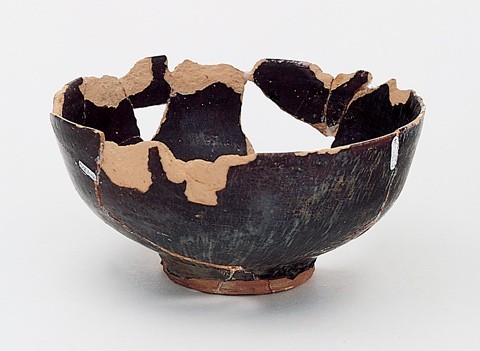
Bowl, Henry Piercy, ca. 1792– 1809. Lead-glazed earthenware. D. 6 1/2". This black-glazed bowl is from the Piercy kiln site.
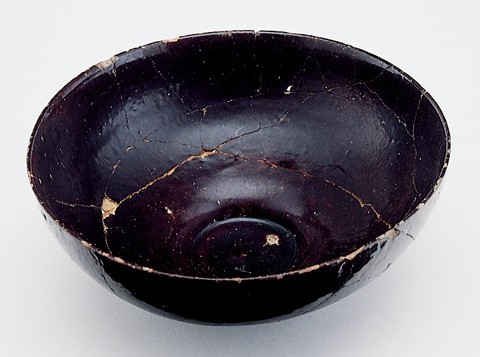
Bowl, Philadelphia, ca. 1770s. Lead-glazed earthenware. D. 8". (Courtesy, National Park Service, Independence National Historical Park, Inde-59910.) Note the well formed by shaping the footring.

Jars, Alexandria, ca. 1792– 1809. Lead-glazed earthenware. H. 8 1/2", 8 1/2", 7".

Utilitarian pots, Henry Piercy, Alexandria, ca. 1792–1796. Lead-glazed earthenware. H. 13", 9". The largest pots have lug handles.
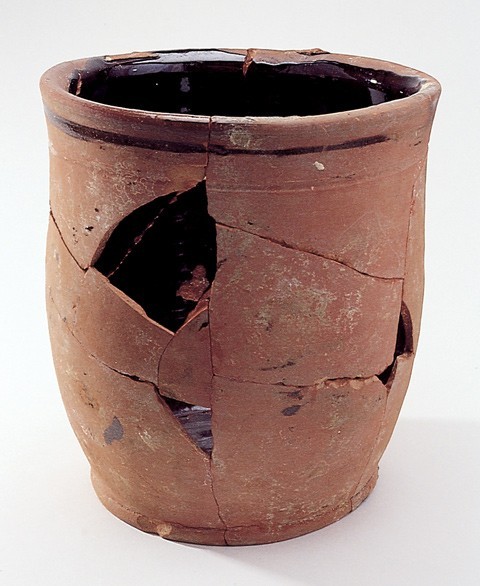
Utilitarian pot, Philadelphia, ca. 1770s. Lead-glazed earthenware. H. 10". (Courtesy, National Park Service, Independence National Historical Park, Inde-57294.)
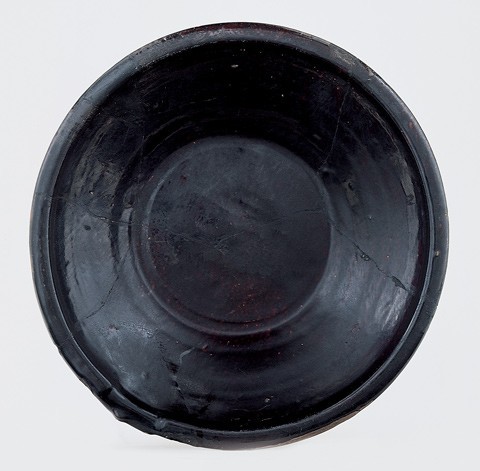
Milk pan, Henry Piercy, Alexandria, ca. 1792–1809. Lead-glazed earthenware. D. 11". Milk pans are glazed on the inside of the vessel and have a pouring spout, seen at lower left. They range in size from 10" to 15 1/2" in diameter. Most are shallow like this example, but a few have steeper sides.
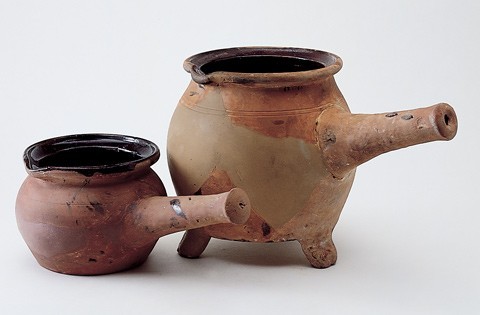
Pipkins, Henry Piercy, Alexandria, ca. 1792– 1809. Lead-glazed earthenware. H. 5", 8 1/2". The small pipkin on the left, from Piercy’s shop, has a flat bottom. An example from a privy on Market Square has tripod feet to raise it above the hot ashes on the hearth.

Flowerpot fragment, Henry Piercy, Alexandria, ca. 1792–1809. Unglazed earthenware. D. 10". This sherd from the Piercy kiln site displays a piecrust flange. Some Alexandria flowerpots also have a piecrust rim and wavy combed lines on the body.
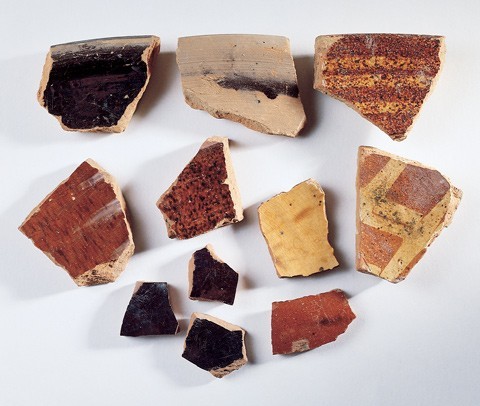
Detail of the piecrust flange of a flowerpot, Philadelphia, ca. 1769. (Courtesy, National Park Service, Independence National Historical Park, Inde-24490.)

Waster sherds attributed to Daniel Topham, Philadelphia, 1766–1783, recovered from the rear of 711 and 712 Arch Street (Block 2 of the Metropolitan Detention Center site in Philadelphia). (Courtesy, Dr. Richard J. Dent, Department of Anthropology, American University.) Included are fragments of utilitarian pots; a slipware pan, dish, and bowl; and black-glazed vessels.
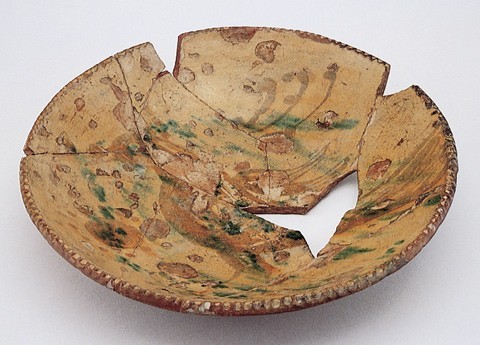
Dish, Philadelphia, ca. 1769. Slipware. D. 11 3/4". (Courtesy, National Park Service, Independence National Historical Park, Inde-24234.) This vessel from Franklin Court has a bird motif.
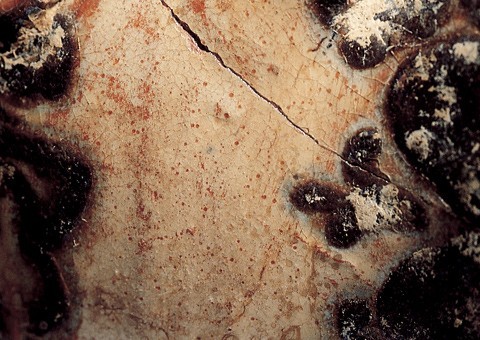
Detail of a hollow ware vessel, Philadelphia, ca. 1769. Slipware. (Courtesy, National Park Service, Independence National Historical Park, Inde-23688.) This vessel from Franklin Court has black on white slip decoration on the exterior.
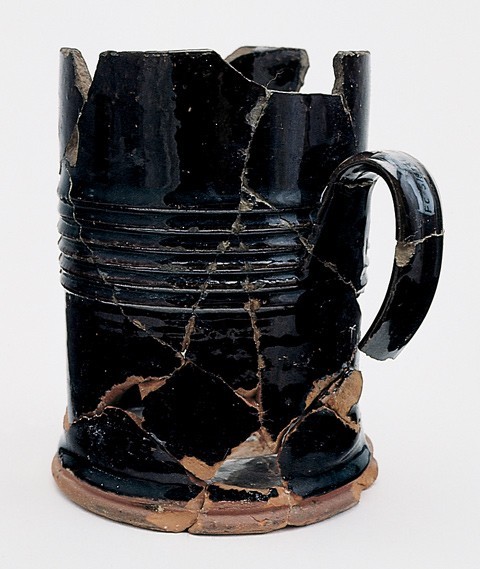
Tankard, Philadelphia, ca. 1769. Lead-glazed earthenware. H. 4 3/4". (Courtesy, National Park Service, Independence National Historical Park, Inde-23646.) This vessel from Franklin Court has a ribbed midsection reminiscent of Buckley ware.

Piercy’s homeland in Saarbrücken, Germany, was a major center of earthenware production. (Artwork by Nichole Drgan and Wynne Patterson.)
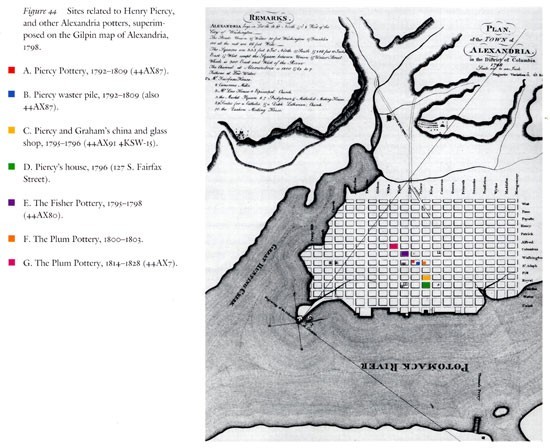
Sites related to Henry Piercy, and other Alexandria potters, superimposed on the Gilpin map of Alexandria, 1798.
A. Piercy Pottery, 1792–1809 (44AX87).
B. Piercy waster pile, 1792–1809 (also 44AX87).
C. Piercy and Graham’s china and glass shop, 1795–1796 (44AX91 4KSW-15).
D. Piercy’s house, 1796 (127 S. Fairfax Street).
E. The Fisher Pottery, 1795–1798 (44AX80).
F. The Plum Pottery, 1800–1803.
G. The Plum Pottery, 1814–1828 (44AX7).
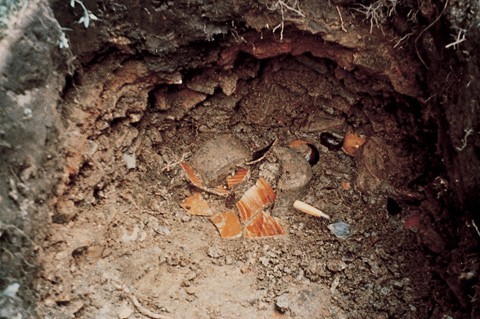
Test excavation at the Piercy Pottery site (44AX87), 1968. (Photo, Richard Muzzrole, Smithsonian Institution.) Note fragments of slipware pans and bowls and black-glazed bowls.
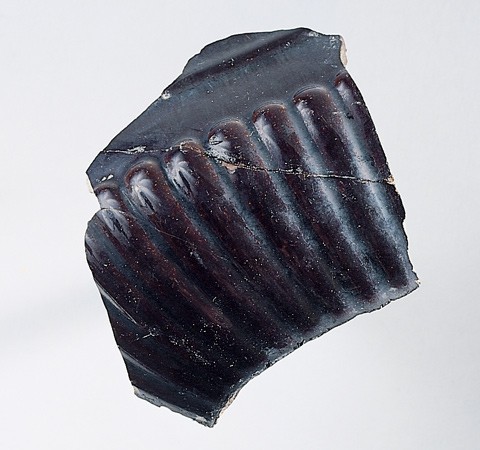
Teapot fragment, Thomas Fisher, Alexandria, ca. 1795–1798. Lead-glazed earthenware. These sherds from the Fisher site have glaze on a broken edge, an indication that the pot broke in firing.

Teapot fragments, Henry Piercy, Alexandria, ca. 1796. Lead-glazed earthenware. These sherds were found at Piercy’s property at 127 S. Fairfax Street. Some have a poorly fired glaze and display marks from contact with kiln furniture or other pots.
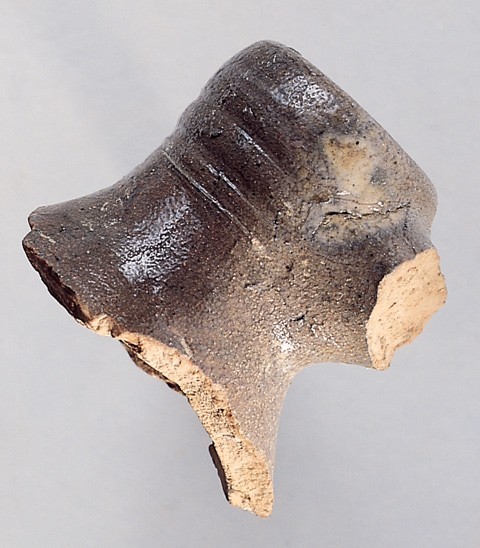
Bottle and jar fragments, probably Lewis Plum, Alexandria, ca. 1799–1809. Salt-glazed stoneware with iron-oxide wash. These wasters were found at the Piercy kiln site.
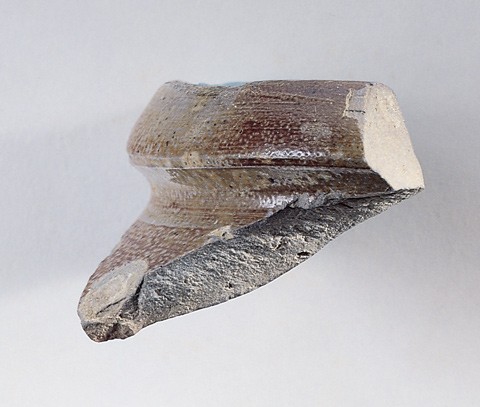
Bottle and jar fragments, probably Lewis Plum, Alexandria, ca. 1799–1809. Salt-glazed stoneware with iron-oxide wash. These wasters were found at the Piercy kiln site.
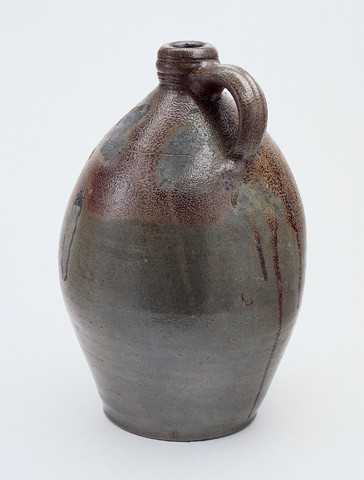
Jug, John Swann, Alexandria, ca. 1813–1820. Salt-glazed stoneware with iron-oxide wash. H. 12". This example is from a domestic site, but many similar wares were found at Swann’s pottery on Wilkes Street. The reeded neck and iron wash are also found on bottle, jug, and jar wasters from the Piercy Pottery. These vessels are attributed to Lewis Plum who rented the pottery in 1799 and with whom Swann apprenticed.
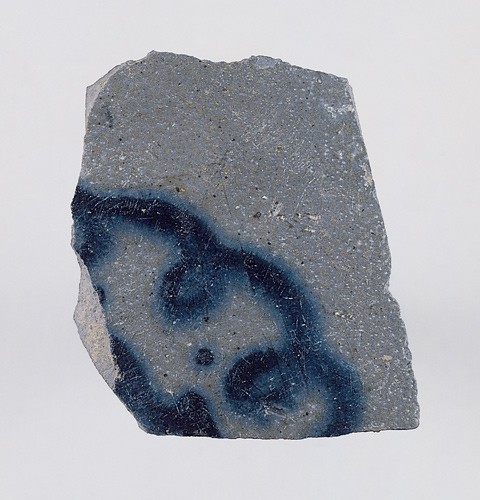
Stoneware fragment, probably Lewis Plum, Alexandria, ca. 1799–1809, from the Piercy kiln site. Salt-glazed stoneware with slip-trailed cobalt.
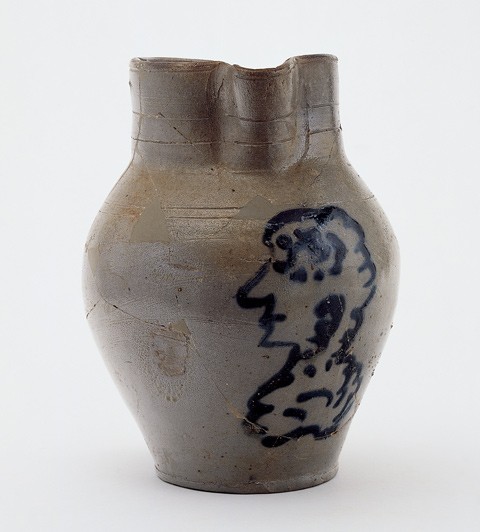
Pitcher, possibly Alexandria, ca. 1799–1820. Salt-glazed stoneware with slip-trailed cobalt. H. 8 1/2". This pitcher from a privy on Market Square has decoration similar to the fragment from the Piercy kiln site illustrated in fig. 50.
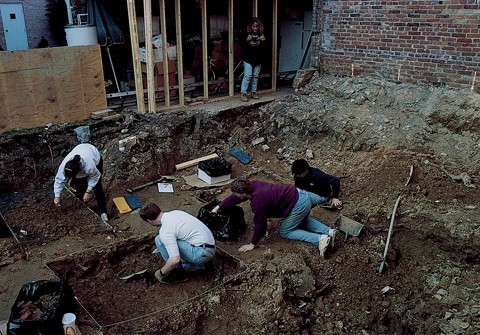
Excavations at the Piercy waster dump (44AX87), 1999. (Photo, Bernard K. Means, Alexandria Archaeology.)
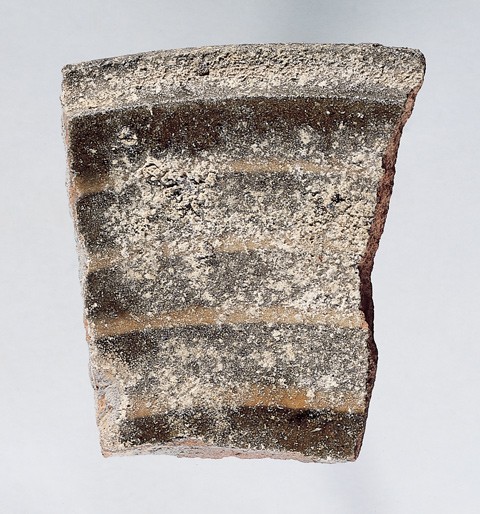
Pan, Henry Piercy, Alexandria, ca. 1792–1809. Slipware. Many wasters from the Piercy Pottery were overfired and discolored, or have a bubbled or pitted glaze. Some, like this slipware pan fragment, are severely burned.

Pan, Henry Piercy, Alexandria, ca. 1792–1809. Slipware. D. 13". This vessel from the Piercy waster pile shows his well-executed, tightly spaced spiraling slip.
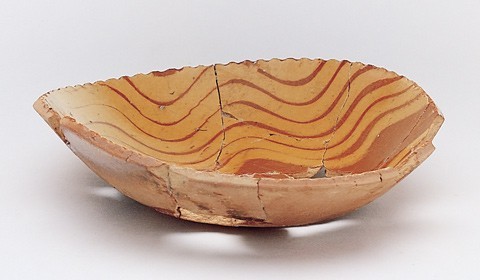
Dish, Henry Piercy, Alexandria, ca. 1792–1809. Slipware. D. 7 1/2". This vessel is from the Piercy waster pile.
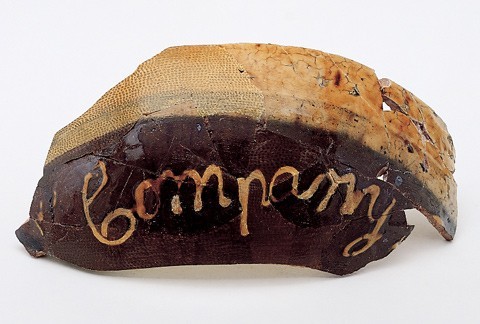
Punch bowl, Henry Piercy, Alexandria, ca. 1792–1799. Slipware. D. 10". The incomplete inscription includes the partial date “17—” and the word “Com(p)any.” This vessel from the Piercy waster pile is the only dated piece of Alexandria earthenware. The stippled surface denotes areas of restoration.
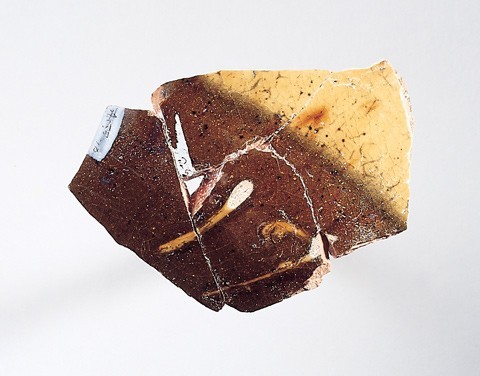
Punch bowl, Henry Piercy, Alexandria, ca. 1792–1799. Slipware. D. 10". The incomplete inscription includes the partial date “17—” and the word “Com(p)any.” This vessel from the Piercy waster pile is the only dated piece of Alexandria earthenware. The stippled surface denotes areas of restoration.

Reconstruction of the Piercy punch bowl illustrated in fig. 56. (Illustration, Andrew Flora.)
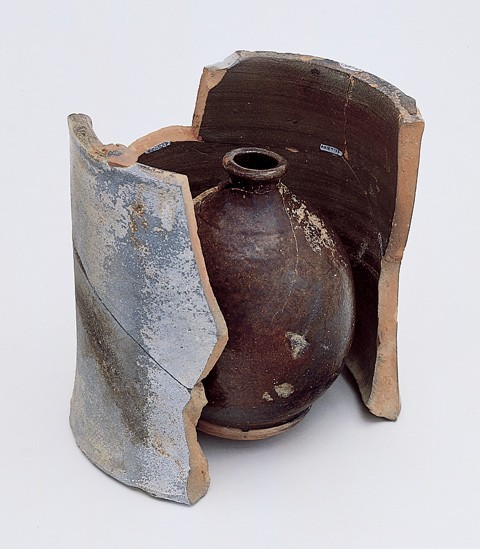
Sagger with syrup jar, Henry Piercy, Alexandria, ca. 1792–1809. H. 8 1/2". The glazed wares were placed in saggers for protection in firing.
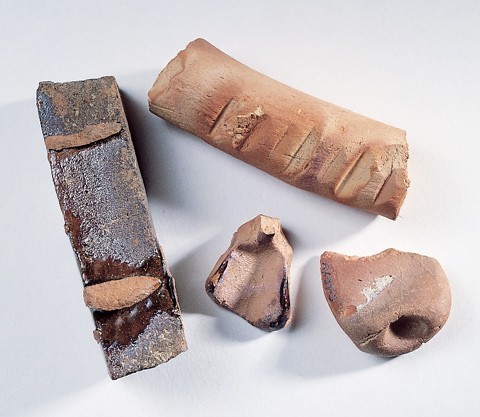
Kiln furniture, Henry Piercy, Alexandria, ca. 1792–1809. Fire bars and wedges were used to separate large pots with heavy rims and to steady the stacks of pottery in the kiln. Small wads of clay were pinched between the potter’s fingers and used to support the pots as they were stacked in the kiln.
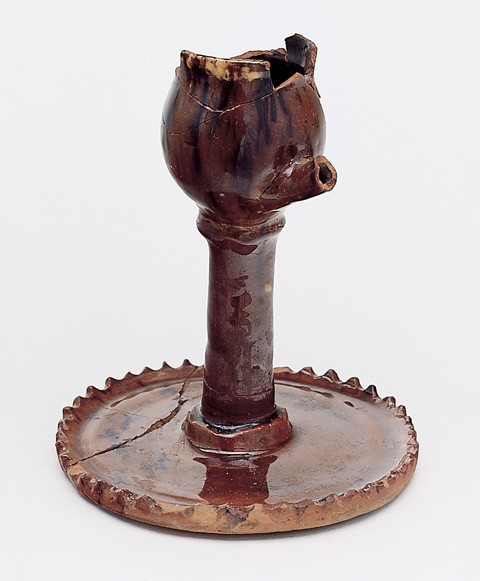
Oil lamp, Henry Piercy, Alexandria, ca. 1792–1809. Lead-glazed earthenware. H. 7 1/2". This lamp is from the Piercy shop. Fragments from a similar vessel were found at the kiln site.

Jar, lid, and vase, Henry Piercy, Alexandria, ca. 1792–1809. Lead-glazed earthenware. H. 5 1/2", H. 2 1/2", Base D. 3 1/4". These atypical vessels with swirls of slip are from the Piercy shop site.

Pan, dish, and dish fragments, possibly Alexandria, ca. 1792–1809. Slipware. D. 11 1/2", 10", and 6 1/2" (extrapolated). A pan from the Piercy shop and a small dish from nearby McKnight’s Tavern have atypical yellow on brown decoration. These pieces were thought to be imported, but similar sherds were found at the Piercy waster dump.
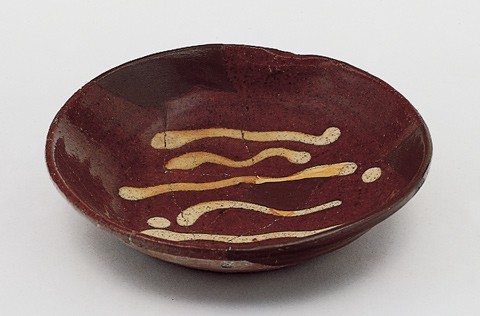
Pan, dish, and dish fragments, possibly Alexandria, ca. 1792–1809. Slipware. D. 11 1/2", 10", and 6 1/2" (extrapolated). A pan from the Piercy shop and a small dish from nearby McKnight’s Tavern have atypical yellow on brown decoration. These pieces were thought to be imported, but similar sherds were found at the Piercy waster dump.
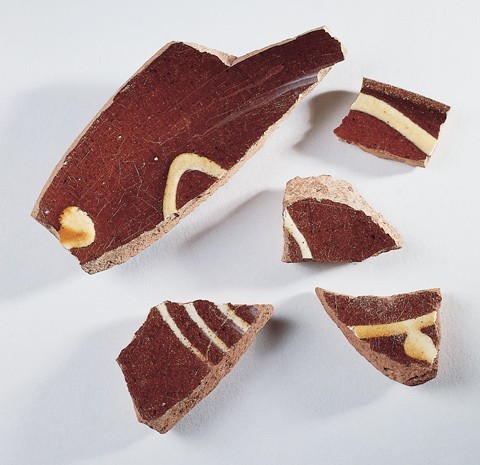
Pan, dish, and dish fragments, possibly Alexandria, ca. 1792–1809. Slipware. D. 11 1/2", 10", and 6 1/2" (extrapolated). A pan from the Piercy shop and a small dish from nearby McKnight’s Tavern have atypical yellow on brown decoration. These pieces were thought to be imported, but similar sherds were found at the Piercy waster dump.
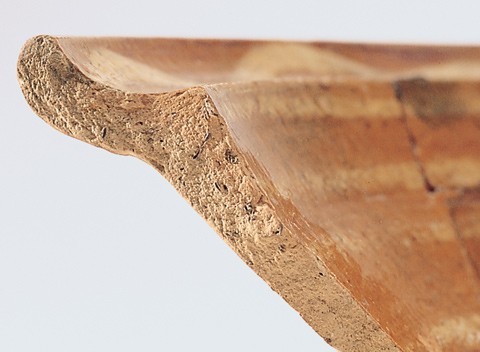
Detail of a pan, Philadelphia, ca. 1770s. Slipware. D. 10 1/2". (Courtesy, National Park Service, Independence National Historical Park, Inde-60179.)
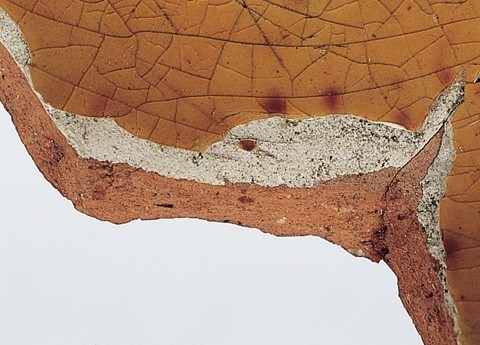
Detail of a bowl, Philadelphia, ca. 1770s. Slipware. (Courtesy, National Park Service, Independence National Historical Park, Inde-60183.)

Dish fragments, Henry Piercy, Alexandria, ca. 1792–1809. Slipware. The appearance is similar to that of Philadelphia wares.
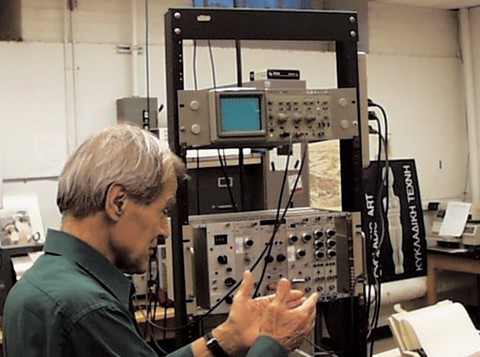
Dr. Romeo Segnan explains Mössbauer spectroscopy in his physics laboratory at American University. (Photo, Bernard K. Means, Alexandria Archaeology.)
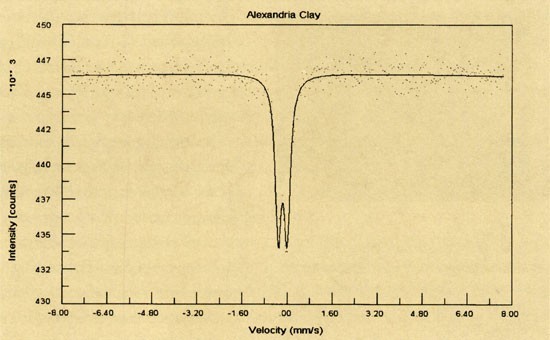
The central peak for the Alexandria clay spectrum shows larger splitting than the corresponding peak in the Philadelphia clay spectrum. (Courtesy, Drs. Romeo Segnan and J. P. Auffret, Department of Physics, American University.)
The earliest earthenware manufactured in Alexandria, Virginia, is linked both historically and stylistically with Philadelphia, Pennsylvania, 150 miles to the north. Alexandria’s first potter, Henry Piercy, arrived there in 1792, having learned the trade at his brother Christian’s Philadelphia pottery where he worked from 1769 until at least 1776. Piercy’s first advertisement in the Alexandria Gazette boasts that his wares are “equal to any work in Philadelphia or elsewhere.”[1] Indeed, the wares of Henry Piercy and his Alexandria contemporaries are stylistically identical to some of the Philadelphia earthenware produced during the last three decades of the eighteenth century (figs. 1-4).
The Philadelphia pottery industry was well established by the mid-eighteenth century, and “Philadelphia Earthenwares” were advertised up and down the East Coast. Philadelphia-style earthenwares, including slip-decorated bowls and trailed and combed wares, have been found in excavations from the Fortress of Louisbourg in Nova Scotia to St. Augustine, Florida, and as far away as Bermuda and Barbados.[2] Philadelphia pottery thus gained a sound and widespread reputation, and was the basis for comparison in advertisements for many potters of the time.
Philadelphia-style pottery was not only imitated in Alexandria but also in Providence, Rhode Island; New York City; and even in rural St. Mary’s County, Maryland. In 1767 Joseph Wilson of North Providence (a town northwest of the capital city) advertised “Earthen Ware at a cheap Rate, made in the best Manner and glazed in the Same Way as Practiced in Philadelphia.”[3] In 1773, a New York advertisement for potter Jonathan Durrell, “the manufacturer late from Philadelphia,” announced that he was making “Philadelphia Earthenware” and that “the ware is far superior to generality, and equal to the best of any imported from Philadelphia, or elsewhere.”[4] As early as 1756, Thomas Baker of St. Mary’s County advertised earthenware “of the same Kind as imported from Liverpool, or made in Philadelphia, such as Milk-Pans, Butter-Pots, Jugs, Pitchers, Quart-Mugs, Pint-Mugs, Porringers, Churning-Pots, painted Dishes, Plates, etc. with sundry other Sorts of small Ware too tedious to mention” made by his “good workmen from Liverpool and Philadelphia.”[5]
When Philadelphia-style pottery is recognized in archaeological contexts, it is generally thought to represent imports from Philadelphia. However, in Alexandria, the locally produced pottery is visually indistinguishable from Philadelphia pottery. This raises interesting questions: How much Philadelphia-style pottery found in archaeological sites throughout America was actually produced in Philadelphia? And how much was produced in other towns, either by potters of Philadelphia origin or by others who learned to emulate the desirable Philadelphia wares?
Archaeologists from Alexandria and physicists from American University are working together to provide the answers and determine if a process called Mössbauer spectroscopy can differentiate between Alexandria and Philadelphia pottery by assessing clay composition and firing conditions.[6] For this study, sherds were analyzed from a waster pile at Alexandria’s Piercy Pottery site and from the Topham Pottery at the Metropolitan Detention Center site in Philadelphia. This research will lay the framework for the study of Philadelphia-style earthenware from other cities, as well as establish a method for distinguishing locally produced wares from those that have been imported from Philadelphia.
Philadelphia Antecedents
The Piercy family came to Philadelphia in 1769 as part of a large influx of German immigrants. Over 100,000 German-speaking people had arrived in Pennsylvania by 1760. This migratory trend began nearly a century before, when William Penn’s agents enticed European redemptioners to come to Philadelphia for land and religious freedom. Although the first known Philadelphia potters were English, several potters emigrated from Germany in the eighteenth century, including French Huguenot Michael Hillegas (1727), Jacob Roat (ca. 1739), Matthias Meyer (ca. 1740), and Jacob Utteree/Udery (ca. 1745). Christian Piercy later purchased land from Hillegas for his pottery in the Northern Liberties section of Philadelphia.[7]
Soon, Philadelphia pottery became an amalgam of English and German styles. The ethnic fusion that took place in the industry was a continuation of that which took place in England a century earlier, when English potters were influenced by potters of the lower Rhineland.[8] Philadelphia’s pottery industry bustled, supplying local needs and markets throughout the Northeast. The city’s archaeological sites reveal that after 1780, wares of local manufacture all but replaced English coarse earthenwares.
The urban potting tradition in Philadelphia predates the rural Pennsylvania German slipware tradition of the late eighteenth and nineteenth centuries. German immigrant potters settled in the rural communities of Bucks and Montgomery Counties around 1760 and produced highly decorated sgraffito and slip-decorated wares, often depicting tulips, birds, and other culturally symbolic motifs. Some of these wares were also made in Philadelphia but are outside the tradition that made its way to Alexandria (figs. 5, 6). The rural Pennsylvania potters migrated south through Pennsylvania to rural Virginia and West Virginia, while urban Philadelphia potters often moved to other urban areas. Consequently, Shenandoah Valley pottery shows more similarity to Pennsylvania folk traditions, and Alexandria pottery follows the simpler Philadelphia pottery types.[9]
Earthenware Types Common to Philadelphia and Alexandria
Collections from three archaeological sites in Philadelphia were examined for comparison to the Alexandria wares (fig. 7). The first collection consisted of kiln-related waster sherds from the Topham Pottery (1766–1783), which was studied in the Mössbauer spectrographic analysis. The second was a collection of kiln wasters from an unknown pottery from a Franklin Court deposit dating to 1769. The third collection, from the Chiller Plant site at Independence National Historical Park, was a deposit of domestic trash from a privy shaft dated circa 1770. These collections yielded many parallels for each of the earthenware types found at the sites of Piercy’s pottery and retail shop.
Slip-Decorated Wares
PANS: Pans, or basins, are wheel-thrown vessels with sloping sides and narrow, everted rims. Although Piercy’s pans (fig. 8) commonly range in diameter from ten to fourteen inches, examples as small as seven-and-three-quarter inches were found in the Philadelphia collections (fig. 9). The pans are decorated with yellow spirals or bands against an orange or red surface. After the pan was formed and dried to a leather-hard state, the decoration was added by turning the vessel as the slip trailed from a slip cup.[10] The vessel’s surface was then covered with a lead glaze, giving a yellow hue to the raised lines of white pipe-clay slip. Piercy was adept at creating finely executed spiral bands that are evenly and closely spaced (fig. 10). The bands of slip generally extend over the pan’s rim and sides, but they may also continue onto the base. A wavy line may decorate the rim or, like the example from Alexandria, display a chain pattern made of two intersecting wavy lines (fig. 11). Pans may be further embellished with powdered copper oxide daubed over areas of the vessel (fig. 12). Some Philadelphia pans include bands of black slip (fig. 13). The latter ornamentation is commonly found on pottery from the Shenandoah Valley, but not seen on Alexandria wares.
CHARGES: Chargers are shallow, rounded vessels with coggled piecrust rims (figs. 14, 15). These large dishes or plates were drape molded, not wheel-thrown. In this process, the potter rolled a circular slab of clay, decorated it, placed it face down over a domed form called a drape mold, and trimmed the edges.[11] On some of the Philadelphia examples, a faint circle from the mold can be seen in the vessel’s center (fig. 16). The mold-drape technique was used on earlier examples of English slipware when the white slip was most often applied over a dark glaze. The slip’s flat surface—rather than the raised bands of slip seen on pans—is proof that the slip was applied before the slab was draped over the mold to achieve the curved shape.
The most common Alexandria pattern is a band of seven combed, straight lines flanked by multiple wavy lines (fig. 17). Some of the bands of slip were combed through while still damp to create a marbled effect (fig. 18). Sometimes green copper-oxide was also applied to examples from both Alexandria and Philadelphia (fig. 19). One piece from Alexandria shows repairs made at the time of manufacture. Small areas of slip were damaged when the vessel was removed from the mold, and repairs were made using mismatched fragments of slip decoration, perhaps from the trimmings of this or another vessel (figs. 20, 21).
BOWLS: A brown or orange glaze provides a background for slip-decorated bowls (figs. 22, 23). The bowls’ interiors were covered in slip, leaving a narrow band at the rim. The slip, appearing yellow, usually was further embellished with brown splotches. Slip was applied in overlapping lobes on bowls from Philadelphia, but it was evenly applied over the interiors of the Alexandria examples.
Black-Glazed Wares
The black or dark brown wares can be divided into three major groups based on their general shape. The presence of wheel marks helps identify function.
NARROW-MOUTHED VESSELS: Bulbous-shaped jugs and pitchers have clearly visible wheel marks on the interior (fig. 24), indicating that the potter could not reach inside to smooth the pot’s surface after it was thrown. Syrup jugs (fig. 25), or bottles, have bulbous bodies, strap handles, and narrow necks with round lips and no pour spout. Pitchers have similar bases and lower bodies but wider necks and pour spouts (fig. 26). Some pitchers in both Philadelphia and Alexandria have a pronounced ridge embellishing the neck of an otherwise plain vessel.
WIDE-MOUTHED VESSELS: A second group consists of rounded vessels with footed bases and smooth interiors. The smooth interior indicates wide-shape vessels—chamber pots, porringers, and bowls—which enable the potter to reach inside and smooth the surface. Chamber pots have either rolled or flat, everted rims (fig. 27). Porringers have strap handles and curved, everted rims (figs. 28, 29). Undecorated bowls generally range in size from five to seven inches in diameter and have a small well in the bottom resulting from the formation of the footring (figs. 30, 31).
STRAIGHT-SIDED VESSELS: A third group of black-glazed wares includes straight-sided tankards with strap handles and plain rims (see figs. 3, 4), and preserve jars with a cylindrical shape, flat or slightly sloping shoulders, and plain or rolled rims (fig. 32).
Utilitarian Wares
Utilitarian wares are unglazed on the exterior, with a dark brown-black (or, rarely, orange) glaze on the interior. The glaze was poured into the vessel and the excess poured out. Smears of glaze can usually be seen on the exterior, below the rim.
POTS: The pots range in size from five to thirteen and one-half inches in height and six to fourteen inches in diameter. The largest pots have lug handles. These vessels held a variety of food products and may have been covered with muslin tied on with string (figs. 33, 34).
MILK PANS: Milk pans are also glazed on the inside and exhibit smears of glaze beneath the exterior rim. These shallow pans have sloping sides and a pour spout, and range from ten to fifteen and one-half inches in diameter (fig. 35).
PIPKINS: Pipkins are long-handled cooking pots with a flat or tripod base and a pour spout (fig. 36).
Unglazed Wares
Unglazed flowerpots are decorated with piecrust rims and flanges, and may display combing. Some examples have round holes pierced through the side, similar to modern-day strawberry pots. Flowerpot trays were also found (figs. 37, 38).
EARTHENWARE FROM TEH TOPHAM POTTERY
Metropolitan Detention Center Site (36PH91)
The Metropolitan Detention Center site is located in Philadelphia’s Center City, on the west side of North Seventh Street, between Arch and Filbert Streets (see fig. 7).[12] Data recovery investigations by Louis Berger & Associates, Inc. focused on the mid-eighteenth- through early nineteenth-century components, although the site saw mixed residential, commercial, and light industrial uses until the mid-twentieth century. One of the site’s most significant finds was an extensive buried landscape surface. The landscape contained evidence of various domestic and craft-related activities, including the manufacture of earthenware pottery.[13] Evidence was also found for the manufacture of brass tacks and straight pins, bone buttons, leather shoes, and wooden furniture.
From 1766 until his death in 1783, Daniel Topham operated a pottery at 50 North Seventh Street, near what is now Filbert Street in Philadelphia. Historical sources indicate that Topham used local clays that were probably obtained from deposits in or near the Metropolitan Detention Center site.[14] He petitioned in 1780 for “The Privilege of Digging clay for the purpose of making bricks and Potter’s Ware on a Certain Lot Situate on the North Side of Race Streets, and between Tenth and Eleventh Streets in the City.”[15]
Topham’s pottery consisted of a “dwelling, pott house, stable and two sheds.”[16] His business was purchased by Andrew Miller in 1785 and operated as a pottery by members of the Miller family until 1840.[17] Although Topham was in debt when he died, by the 1820s Miller and his sons had expanded the business from craft to industrial production, including the manufacture of fire brick, tile, furnaces, and sugar molds. The family was also experimenting with the manufacture of white earthenware and lusterwares.[18]
Daniel Topham was a contemporary of Henry and Christian Piercy in Philadelphia and was influenced by the same stylistic traditions. Traces of pottery produced by Topham were recovered from a group of excavation units (designated Block 2) located in the rear of the 710 and 712 Arch Street lots.[19] These fragments were attributed to Topham, rather than Miller, because of the earlier date of deposition.[20] The highest percentage of redware sherds at the Metropolitan Detention Center site was identified from this area, as was kiln furniture and sherds that were interpreted as possible kiln wasters.[21] These material remains represent indirect evidence of Topham’s pottery, since construction of a department store probably destroyed his kiln and pot house. Topham apparently disposed of his broken kiln furniture and wasters near the kiln in an attempt to fill a low-lying and swampy area.[22]
The kiln furniture from Block 2 is similar in form to that found at the Piercy site in Alexandria. Glazed pots were fired inside of the saggers, which came in two basic shapes. One form was cylindrical, like the Alexandria saggers, and the other had in-sloping sides. Their base diameters ranged from six to twelve inches, with most in the eight- to nine-inch range. Other types of kiln furniture included tiles, fire bars, and small wedges, many of which showed fingerprints.[23] A total of 464 fragments of kiln furniture was recovered, along with 193 sherds of coarse earthenware.
Of the earthenware sherds, some were clearly domestic trash; some had charring on the exterior, indicating their use over an open fire; and a few were recognized as imported wares. Most, however, were thought to be kiln wasters: sherds with glaze on the broken edges from breakage in the kiln; sherds adhering to other vessels from explosions in the kiln; or sherds from severely warped vessels. Many of the other earthenware sherds are also likely to be wasters, although they only exhibit breakage from the disposal process.[24]
Topham’s inventory, recorded at his death in 1783, included “a quantity of burndt earthen ware, such as Pints, Basons, bowls, juggs, potts, etc.”[25] The sherds—remnants from slip-trailed pans (“Basons” in the inventory) and chargers (“dishes” in the site report)—recovered from Block 2 are clearly similar to Alexandria wares in rim forms, basic decorative types, and appearance of the clay body and glazes (fig. 39). Although many fragments are decorated similarly to the Alexandria wares, there is some variation, such as a criss-cross pattern seen on one charger sherd. Black- or dark brown-glazed milk pans were the next most common form retrieved. Slip-decorated bowls, dark-glazed jars, porringers, pitchers, chamber pots, tankards (“Pints” in the inventory), and utilitarian pots were also found.
Similar forms and decoration were found on earthenware recovered from Feature 19, a privy at 702 Arch Street. These fragments, however, are from a deposit of domestic trash dating to circa 1795–1815, and may be associated with Andrew Miller or another potter from this later period. The earthenware from Feature 19 also exhibits a wider range of decorative styles of slipware than found in Alexandria, but it includes similar chargers, pans, bowls, syrup jars, and chamber pots.
With the cooperation of the lead investigator at the Metropolitan Detention Center site, Professor Richard J. Dent, samples were selected for physical analysis and clay sourcing from among the kiln wasters in a single unit in Block 2.[26] The selected earthenware wasters were produced by Daniel Topham and are similar in form and shape to Henry Piercy’s wares.
EARTHENWARE FROM FRANKLIN COURT
Independence National Historical Park
Three mid-eighteenth-century privy deposits (Features 9, 22 and 25) from the Franklin Court site (see fig. 7) revealed large assemblages of artifacts from a local pottery, including earthenware wasters and kiln furniture.[27] These artifacts were found in association with other trash dating to circa 1740–1765. The kiln-related material was thought to have been brought from nearby, around 1769, as privy drainage base fill. Similar kiln-related materials were found under the paving of Oriana Street from extensive filling and grading for the site of Franklin’s new house.[28]
The range of decoration on these colonial Philadelphia wares was broader than that used in Alexandria in the 1790s, and included more clearly Germanic forms. However, many of the wares are similar to those later made by Henry Piercy. A similarly dated domestic deposit from the Chiller Plant site on Independence Mall contained many of the same wares.[29]
The Philadelphia chargers from the Franklin Court site are marbled, sponged, striped, or combed, while Alexandria wares are limited to striped or combed lines. Trailed-slip designs, used primarily on shallow pans with sloping sides, include examples with floral, foliate, or bird motifs, as well as the yellow banding or spirals found in Alexandria (fig. 40). Slip is applied to bowls in the lobed, or “petal,” pattern.
Some examples of sgraffito or scratched decoration (see fig. 6) were found at Franklin Court, but this technique is little used by the end of the eighteenth century and is not found in Alexandria. Sgrafitto, used in England and Northern Europe and common in the rural Pennsylvania Dutch tradition, was also used in the Shenandoah Valley.[30] Also recovered from Franklin Court are vessels covered by white slip with applied trailed-slip designs in black (fig. 41). Sgraffito and the slip-trail technique often depict birds or flowers. Decoration applied over white slip was later used by Shenandoah Valley potters such as John Bell and J. Eberly.[31]
In both Philadelphia and Alexandria, handled porringers, tankards, chamber pots, pitchers, and syrup jugs (round bottles) are black glazed on both interior and exterior. Some of the Philadelphia examples, like those from Alexandria, have no ornamentation. Others have a ribbed midsection (fig. 42) reminiscent of Buckley ware (a contemporary English coarseware with an agate clay, thick black glaze, and, often, ribbing).[32] Bowls appear in both plain and slip-decorated versions. Utilitarian milk pans, pots, and pipkins are glazed only on the interior.
Although the Franklin Court assemblage has more variety in both style and form, nearly all of Henry Piercy’s wares are identical to examples found at Franklin Court. More than twenty-five years after the Franklin Court kiln wasters were discarded, a well-entrenched Philadelphia style was still evident in Philadelphia as well as in Alexandria. A later assemblage of household debris at Franklin Court (Feature 26), with a date range of circa 1780–1800, contained vessels similar to the earlier kiln-related assemblages.[33] Piercy continued to make wares in Alexandria in the 1790s that had been in vogue upon his arrival in Philadelphia in 1769, but these same styles also continued to be made in Philadelphia at the century’s end.
HENRY PIERCY AND THE ALEXANDRIA POTTERS
The Piercy Family
Henry Piercy was born in Saarbrücken, in Germany’s lower Rhineland, in 1756 (fig. 43). At age thirteen, he immigrated to Philadelphia with his family. His parents, John Jacob Piercy (1707–1769) and Anna Cunigundo Piercy, had six children. Christian, Jacob, and Henry Piercy were potters. There was another brother, George, and two sisters whose names are unknown.[34]
At age twenty-five, Christian became head of the household when his father died the same year the family arrived in Philadelphia. Christian’s home was in the Northern Liberties section of Philadelphia, at 296–298 North Front Street.[35] His pot house was nearby (see fig. 7). Christian’s first mention in the Pennsylvania Gazette was in 1774, when he offered a reward for a runaway apprentice.[36] As Captain of the Fifth Philadelphia Militia, he served at Valley Forge during the winter of 1777 to 1778.
Henry Piercy, the youngest brother, learned the pottery trade from Christian and worked with him for seven years before enlisting in the Revolutionary army in 1776 at age twenty. He was promoted to lieutenant in February 1777. Henry was an aide-de-camp to George Washington and an original member of the Society of the Cincinnati.[37]
Christian’s great-grandson Joseph Fornance recalls a family story “that while at Valley Forge, being a potter, he built a kiln and made a lot of dishes for the soldiers. But the needs of the soldiers were so great that when the kiln was opened they rushed in and took all the dishes, leaving him none for his own use.”[38] (Brothers Jacob and Henry also served at Valley Forge.)
After the war, Christian returned to his successful pottery business in Philadelphia. He and potter Michael Gilbert led twenty potters in the Grand Federal Procession in Philadelphia in 1788. Along with one of his eight children, he died in the yellow fever epidemic of 1793 at age forty-nine. On January 4, 1794, the Pennsylvania Packet announced the public sale of his potting business and household effects, but notices in May 1794 and July 1795 stated that the business would continue.[39]
Henry may have returned to Philadelphia with his brother after the war, but he was not listed in the 1790 census. In April 1792, he was living in Trenton, New Jersey, and had been appointed a master mason in Trenton Lodge #5. By November of that year, he had moved to Alexandria and opened his “Manufactory of Earthen Ware.”[40]
After Henry moved to Alexandria, he married Mary Burroughs. He had no children but took in his niece Catherine and nephew John after their father Christian’s death. “Henry Piercy/Lewis Plumb/John Piercy” was recorded on the 1797 tax rolls, indicating John’s involvement in the pottery. In 1798 John was back in Philadelphia, listed in the city directory as a potter at 324 North Front Street.[41] At age twenty-one, John may have returned to run his late father’s business or another nearby pottery.
Henry Piercy was a prominent member of Alexandria society, serving on three grand juries between 1795 and 1797. As a Mason, he was elected junior warden of Alexandria Lodge #22 in 1793, and was senior warden from 1797 until 1801. He also commanded a company of military volunteers, the Independent Blues of Alexandria, whom he paraded in honor of George Washington’s visit to Alexandria on November 6, 1798, and again the following year at Washington’s funeral. Henry leased his pottery business in 1799, apparently no longer active in the business. That same year, he received a commission as captain in the Eighth Infantry Regiment. When Henry died in June 1809, the Lodge marched with a military escort to the Old Presbyterian Meeting House for the funeral, and he was buried in the Episcopal burial grounds.
The Town of Alexandria
The town of Alexandria was established in 1749 after a group of merchants and landowners petitioned the General Assembly for creation of a market town. But even before this, seventeenth- and eighteenth-century plantations dotted the countryside. Waterworn ceramics from the third quarter of the seventeenth century, which were found in fill beside a later wharf, are indicative of ships ballast and suggest port activity more than fifty years before the town’s establishment.[42] By the 1730s Hugh West had established a tobacco warehouse, a ferry service, and a tavern on the bluff overlooking the city’s bay. And Philip and John Alexander farmed the surrounding land. In 1749 a street grid was established over a sixty acre area, and eighty-four half-acre lots were sold at auction. In 1752 the Fairfax County Courthouse moved to Alexandria, establishing the new town as the regional center of northern Virginia. Over the next half century Alexandria continued to grow, expanding to the west with the sale of new lots. The steep bluffs on the Potomac were cut down to fill the shallow half-moon bay, increasing valuable commercial property and deepening the harbor. The town was incorporated in 1779, and in 1789 some of its area was included in the parcel given by Virginia to form part of the new District of Columbia.
By the end of the eighteenth century, Alexandria’s designation as an official port of entry enabled foreign ships to land and unload without registering elsewhere. Fronting the Potomac River, the city became one of the ten busiest ports in America, with one thousand ships arriving each year.[43] Henry Piercy was one of many settlers from Philadelphia who was attracted to the thriving town. In 1792, the year that he arrived, a law was passed exempting artisans, mechanics, and handcrafters who migrated to Virginia from taxes on implements of trade and from other taxes apart from those assessed on land. This exemption was in effect until 1826 and encouraged the migration of skilled craftsmen.[44] That many of the craftsmen came from Philadelphia is alluded to in an 1816 issue of the Alexandria Gazette: “The houses are generally built of brick and upon the less modern Philadelphia plan, the most of the mechanics having been from that place.”[45] In 1816 Alexandria potter Lewis Plum was also still producing earthenware of the “less modern Philadelphia” style.
Before 1792, when Piercy and other craftsmen were encouraged to move to Virginia, Alexandria homes and businesses used utilitarian pottery imported from England, Germany, and other parts of America, including, most likely, Philadelphia. Archaeological excavations primarily show German and English stoneware and English earthenware before circa 1790. In Piercy’s first advertisement in 1792, he asks for “the patronage of all those who wish to encourage home manufactures.”[46] Home manufactures were indeed encouraged by Alexandrians, and utilitarian wares found on archaeological sites dating from the 1790s through the 1870s appear mostly to be of local manufacture. Chemical analysis to determine the clay source of Philadelphia-style earthenware found on residential sites (beyond the scope of our current research) will be necessary to determine whether the wares are indeed of local manufacture, or if they were imported from Philadelphia even after Piercy’s business was well established.
Henry Piercy’s Business Ventures
As Alexandria’s first known potter, Henry Piercy introduced the Philadelphia style of pottery to other potters who worked alongside or in competition with him. Slip-decorated pans and other Philadelphia forms continued to be made with little change for around thirty years, until stoneware had all but replaced earthenware. Between 1792 and 1876, Alexandria had at least seventeen potters working at nine different potteries, producing earthenware and, later, stoneware.[47]
Piercy built his pot house on a quarter-block lot on the northeast corner of Washington and Duke Streets. At the time, the location was on the outskirts of town, where noxious fumes from the kiln and danger of fire would be of less concern (fig. 44).[48] In 1795 Thomas Fisher built a second pot house opposite Piercy’s, on the southwest corner. As demonstrated from wasters discovered in test excavations in the 1960s, these potteries produced similar wares in the Philadelphia style.[49]
Piercy was also involved in retail ventures. On November 1, 1792, he advertised “for sale at his house, the upper end Prince Street, a large assortment of CHINA QUEEN’s WARE and GLASS.”[50] He also sold china and glass from a shop on King Street, between Royal and Pitt Streets, which was in operation for only ten months. On June 20, 1795, the local newspaper advertised:
PIERCY AND GRAHAM Have Just Received and Now Opening for Sale Opposite Mr. McNight’s Tavern, King Street, a neat and general assortment of DRY GOODS . . . Amongst which are a beautiful assortment of NANKEENS . . . Also an Assortment of China and Glass.[51]
Significantly, a well behind this shop was excavated in 1974, and the eighty vessels of Piercy’s manufacture that were recovered can be dated to the brief ten-month time period.[52]
According to tax records, Piercy formed a partnership with his nephew John Piercy and potter Lewis Plum in 1797, while Fisher went into partnership with potters Thomas Hewes and James Miller. Henry Piercy and Fisher were working together by March of 1797 when they advertised the opening of their Alexandria “Delfware manufacture” in a Norfolk, Virginia, newspaper. Nothing resembling tin-glazed delftware has been found, however, at the Piercy or Fisher Potteries, or in any Alexandria pottery site.[53] Tax records of 1798 confirm the Piercy and Fisher partnership. The two operated the Piercy Pottery for a year before renting it to their former partners Lewis Plum and Thomas Hewes. The Fisher Pottery is not mentioned in tax records or other documents after 1798, and may have been closed. Piercy may no longer have been actively engaged in potting by then, but he continued to own the pot house until his death in 1809.[54] Plum and Hewes rented the pot house for just one year (1799–1800), and then Plum opened a competing pottery one block away, on the northwest corner of Prince and St. Asaph Streets.
The Piercy Pottery was rented next to Joseph Hibberd. Hibberd had apprenticed with David Brown in Baltimore. He moved to Waterford, Virginia, just a few months after the following announcement appeared in the Alexandria Advertiser on October 13, 1801:
Joseph Hibberd, Late from Baltimore, Respectfully informs the public that he has commenced the Potting Business at the pot-house formerly occupied by Capt. Henry Piercy where he manufactures & has for sale at the most reduced prices for case, by wholesale or by retail, a large assortment of coarse Earthenware of the best quality.
In 1805 the next—and last—known tenants were Thomas Hewes and James Miller. They both had worked at the pottery previously as partners with Fisher in 1797. Hewes had also rented the Piercy Pottery in 1799 with Lewis Plum, while Miller worked at Plum’s new pot house on Prince Street in 1800.
Two months after Piercy’s death, the property was offered for lease. The advertisement described “three frame buildings, one has been used as a pot house, but could easily be altered into anything else, as it is a large and strong building.”[55] A month later, on November 1, 1809, a public sale was held on the premises for “The POT HOUSE, formerly occupied by Captain Piercy, with the Kiln, Mill, etc., the whole must be removed before the 10th of November next.”[56] On November 1, 1810, the land was deeded to Jonathan Scholfield in return for an annual ground rent. The property, with two wooden buildings and three new brick houses fronting on Washington Street, was offered for lease in April 1811. The property was expanded to six brick houses, which survive today, and are known as Lloyd’s Row. The pot house, the third frame building mentioned in the 1809 advertisement, had apparently been removed. It has been conjectured that Scholfield may have moved it two blocks south to Washington and Wilkes Streets, where he was assessed for a pot house in 1812.[57] John Swann, Lewis Plum’s apprentice from 1803 until 1810, purchased the Wilkes Street lot containing this pot house in 1813. Salt-glazed stoneware was manufactured there until 1876, first by Swann and later by B. C. Milburn and his sons.
EXCAVATION OF THE ALEXANDRIA POTTERIES AND RELATED SITES
Test Pits at the Piercy and Fisher Potteries
In 1968, a test pit was excavated on the Piercy Pottery site (44AX87) in the backyard of one of the Lloyd’s Row townhouses (fig. 45), and in 1969 another was excavated on the Fisher Pottery site (44AX80). Artifacts from the Piercy site include slip-decorated chargers, pans, and bowls; dark brown-glazed chamber pots, porringers, tankards, jugs, and pitchers; and utilitarian pots and milk pans, glazed on the interior. Similar wares were excavated at the Fisher Pottery along with some flowerpot fragments. These same forms, and the same decorative motifs, are found at all of the Alexandria pottery sites, and in Philadelphia.[58]
Fragments of a molded teapot were found at the Fisher site. The sherds, obvious kiln wasters, have glaze on the broken edges. Fragments of two similar teapots were found at another Piercy property at 127 South Fairfax Street. The black-glazed teapots are oval in shape, with molded fluting in imitation of silver teapots (figs. 46, 47). Similar sherds have been found at domestic sites in Alexandria. Teapots were made in Philadelphia as early as the mid-eighteenth century, but they were not a common American product until the 1820s.[59] The imitation of silver teapots in clay reached its zenith later in the nineteenth century with the production of silver luster or “Poor Man’s Silver.” This English ware displayed a platinum wash applied to the surface of a molded, black-glazed pot.
Sherds of gray, salt-glazed stoneware were also found at both sites (fig. 48). Some are obvious wasters and might be attributed to Lewis Plum, who first worked at the site in 1797. Similar wares were absent from the 1795–1796 deposit associated with Piercy and Graham’s shop, but were found at Plum’s later pottery on Wolfe Street and at the Wilkes Street Pottery, which was opened by Plum’s apprentice, John Swann, in 1813 (fig. 49). Recovered forms include bottles, chamber pots, jars, and jugs. Some jars are covered with a brown iron wash. One fragment from a pitcher or jug from the Piercy site has a loopy line of slip-trailed cobalt that may represent the hair of a figure in profile, like the one on a pitcher from a nearby site (figs. 50, 51). Slip-trailed cobalt is not seen again in Alexandria until it is made by B. C. Milburn after 1841. However, this bulbous-shaped pitcher appears to be earlier than the forms produced by Milburn.[60]
The Piercy Waster Pile
A much larger collection of Piercy wasters was recovered in 1999, when an extensive waster dump (also part of 44AX87) was encountered during construction of a house addition at 211 South St. Asaph Street (fig. 52). The house lot lies just outside the quarter block that was occupied by Piercy’s pot house, and the property was never owned or rented by Piercy or the other potters.[61] At the Franklin Court site, pottery wasters and kiln furniture were used in extensive filling and grading to solve drainage problems.[62] The waster pile at 211 South St. Asaph may have served a similar need. Alexandria Archaeology collected artifacts from a construction backhoe pile and excavated three five-foot square excavation units. More than 6,000 waster sherds (fig. 53), representing at least 250 vessels, were recovered from this area. In addition, 7,800 fragments of kiln furniture were found.[63] Excavations covered one-third of the area impacted by the addition. The huge waster pile extended beyond the limits of the new addition and under an earlier addition at the rear of the house. In fact, a new foundation had to be constructed for the addition because it rested directly on the unstable waster pile. A few sherds of creamware, pearlware, glass, bone, oyster shells, and other artifacts from the 1790s were found among the wasters and kiln furniture.
Earthenware
Slipwares include at least twenty pans (fig. 54), eight chargers (fig. 55), and thirty-two bowls. The only known dated Alexandria earthenware—a ten-inch punch bowl—was found at this site (figs. 56, 57). The bowl has yellow-appearing white slip on the interior and the upper half of the exterior, and is spattered with brown manganese or iron oxides. The vessel is similar in appearance to eighteenth-century Staffordshire slipware.[64] However, the English examples were made from a white clay, the lower half of the vessel dipped in a black slip. The Alexandria bowl has a black glaze underlying the white slip. Below its yellow band, an inscription in yellow-trailed slip encircles the pot. Although incomplete, the recovered fragments read simply “17—’’ and “Com(p)any.” The partial lettering may refer to an organization or military company, or may be part of a saying, such as “In Good Company.” A similarly shaped punch bowl, plain with a yellow interior and rolled rim, was found at the nearby site of McKnight’s Tavern.
Black-glazed wares represent the largest group of wasters from this site, with ninety-three vessels identified. Of thirty-nine narrow-mouthed vessels showing visible wheel marks on the interior, at least fifteen were identified as syrup jugs and four as pitchers. Of the wide-mouthed vessels, there were at least twenty-three chamber pots, including seven with rolled or flat, everted rims. This group also includes ten porringers and five bowls. Straight-sided vessels include ten tankards and seven preserve jars. A few orange-glazed vessels were also found. Evidence from Piercy’s shop and other sites indicates that some of these shapes, including milk pans, pots, jugs, jars, bowls, and porringers, were also produced with a glaze that appears bright orange. From the kiln site, only one porringer and one bowl with brown splotches displayed the orange glaze. Four more bowls with a dark olive-green glaze and grayish body were probably intended as orange, but overfired.
At least fifty utilitarian milk pans and pots were found, and are still undergoing analysis at the time of publication. All examples have a black or dark brown-glazed interior and streaks of glaze near the rim of the unglazed exterior. Pots with orange glaze are known from the Piercy shop site. The larger pots have lug handles, like the ones found at the shop site. Milk pans have shallow, sloping sides and pour spouts. Two examples of unglazed flowerpots and a flowerpot tray were also found. These pieces have flanges and piecrust rims, and are similar to ones later produced at the Plum pottery and found on domestic sites in Alexandria.
Stoneware
Fragments of only five stoneware vessels—some obvious kiln wasters—were found in the recent dig, but eighteen were found in the 1968 dig. They are thought to have been made by Lewis Plum who rented the pottery site in 1799, and who went on to produce both earthenware and stoneware at another site. Bottles were found in the waster dump, and bottles, jars, jugs, and a chamber pot in the earlier dig. Some have a gray, salt-glazed surface, and some are covered with a brown iron-oxide wash.
Kiln Furniture
The kiln furniture consisted of saggers, tiles, fire-bars, and wedges. Most common (nearly 7,000 fragments) were heavy clay saggers used to protect the more delicate pottery in the kiln during firing (fig. 58). These vessels are easily distinguished from the pottery product itself, having straight sides, plain flat rims, no glaze, and a notch, or air vent, in the rim that allows heat to enter and fire the pots evenly. Ranging in size from seven to ten inches in diameter and five to eight inches high, they were reused and show effects of the heat. Some even show evidence of the vessels that were fired inside them. Occasionally, the shadow of a pot’s base or small puddles of glaze can be seen. Bowl rims adhere to the sides of a number of saggers. And on one, the top of a syrup jar adheres to the interior of the sagger’s base, indicating the sagger was placed upside down over the jar.
Heavy, one-inch thick flat tiles were used to support stacks of pottery or saggers in the kiln. More than 550 fragments were found, representing around 250 tiles. Shadows, or glaze spills, ranging from two to fifteen inches in diameter, indicate the size of vessels or saggers that sat on many of the tiles. For instance, many of the footed bowls have two-inch diameter bases, while pan rims may be as large as fifteen inches. Most shadows are eight to ten inches in diameter and may show contact with saggers. Several tiles have distinctive shadows from syrup jar rims, indicating that they were placed inside saggers, with a tile placed on the sagger’s top to support another layer of pottery in the kiln. Fragments of pottery vessels, other tiles, saggers, wedges, and brick were found adhering to the tiles.
Larger pots with heavier rims were stacked one upon the other, and separated and steadied as needed with kiln furniture and small wads of clay. One hundred and nine rectangular fire bars and 190 wedges show signs of reuse and repeated firings. Sixteen rounded fire bars and thirty-five small wads of clay were probably used once, then shaped and placed directly on the pot rims to separate them in the kiln (fig. 59).
The Piercy and Graham Shop
The brick-lined privy shaft excavated in 1974 at the rear of 406 King Street (44AX91 4KSW-15) was five feet wide, five feet deep, and contained several hundred vessels of Piercy’s manufacture. The vessels date from the short period, June 1795 to April 1796, when Piercy and Graham operated a dry goods shop at this location. The ceramics in the collection—slip-decorated bowls, pans and chargers; black-glazed bowls, porringers, pitchers, syrup jugs, jars, chamber pots; and an orange-glazed porringer—are identical to those from the Piercy kiln site and waster pile. Utilitarian forms, glazed on the inside, include pots from five to fourteen inches tall, the larger with lug handles; milk pans; and a flat-bottomed pipkin.
A few more unusual pieces can probably be attributed to Piercy. An oil lamp has crimped edges on the base and yellow slip at the rim (fig. 60). Fragments of what appears to be the bowl of a similar lamp were found at the kiln site. A preserve jar has the typical cylindrical shape, but is decorated with brown and yellow slip on an orange glaze. A lid, perhaps from a small teapot, is the only one known from Alexandria. A vase shaped like a Chinese garniture urn is decorated similarly to Piercy bowls, with a brown glaze and yellow slip topped with brown oxides (fig. 61). Fragments from the base of a similar vessel were found at the assemblage of Piercy pottery from 127 South Fairfax Street. Despite its similar shape and clay body, a pan with atypical yellow on brown decoration was thought to be an import until similar sherds were found at the Piercy waster dump (fig. 62).
Piercy’s Property at 127 South Fairfax Street
In June 1796, Piercy advertised a store and cellar for rent at 127 South Fairfax Street.[65] In 1974, a contractor found “a half barrel of large Piercy sherds in one pile that apparently had been a yard clean up.” These 289 sherds, representing a minimum of forty-one vessels, are in the collection of the Alexandria Archaeology Museum. Plain pots, milk pans, and slip-decorated pans make up more than half of the collection. Other common Piercy forms include slip-decorated chargers (one with green copper-oxide splotches) and bowls; brown-glazed bowls, large pitchers or jugs, and a jar; and an orange-glazed porringer. Three of the vessel forms have not been found on other Alexandria sites. One small outward-sloping vessel is probably a glazed flowerpot with brown speckling on both the yellow-slipped exterior and orange-glazed interior. The others, all with brown-glazed interiors, include a vessel with a thin handle that, perhaps, is a ladle or pap-boat (feeding dish); and a lidded jar or churn with an everted rim to support the lid. Fragments of two molded teapots, one a kiln waster, were also found. The teapots are similar to one found at the Fisher kiln site (see figs. 46,47).
The Plum Pottery
In 1975 a twenty-foot backhoe trench was excavated on the southwest corner of Wolfe and South Columbus Streets (44AX7). Pieces of kiln flooring and earthenware wasters more than six feet beneath the ground surface were uncovered. Lewis Plum, who had rented the Piercy Pottery in 1799, purchased this property in 1801. He produced pottery here at least as early as 1814, after operating another manufactory on the northwest corner of Prince and St. Asaph Streets. After Plum’s death in 1821, the pot house was operated by Evans and Griggs until 1828. Earthenware and stoneware wasters, similar to those found at the Piercy site, were recovered from this site, but the collection awaits further analysis. Most of the waster sherds, however, appear to be of utilitarian and black-glazed wares. The assemblage also includes slip-decorated wares and stoneware.
DIFFERENTIATING BETWEEN PHILADELPHIA
AND ALEXANDRIA EARTHENWARE
Visual Appearance
The visual appearance of the fired clay, glazes, vessel forms, and decoration of the standard forms produced by Henry Piercy and his contemporaries in Alexandria is identical to that of Philadelphia pottery (figs. 63-65). The wares include slip-decorated pans, chargers and bowls; black-glazed syrup jugs, pitchers, preserve jars, tankards, chamber pots, bowls and porringers; and utilitarian pots and milk pans. In order to differentiate between Philadelphia and Alexandria versions of these wares, and those produced elsewhere “in the Philadelphia style,” archaeologists need to turn to physical analysis and clay sourcing.
Physical Analysis and Clay Sourcing
The physical structure and appearance of coarse earthenware ceramics, such as those of the types manufactured by Henry Piercy and various potters in Philadelphia, are susceptible to the vagaries of the production process and the clay sources used. Temperature fluctuations, differential air flow, variations in vessel shapes and thickness, and, of course, raw clay drawn from a variety of sources, are a few of the factors that can result in visually distinct differences in the clay bodies of coarse earthenwares. Vessels produced during the same firing episode at the same kiln may look subtly different from one another, and even different parts of individual vessels can exhibit recognizable distinctions.
Despite these factors, the coarse earthenwares manufactured by Henry Piercy have an overall consistency in the appearance of their clay bodies. They are generally very porous and light in weight, with a light buff-orange color and no visible inclusions. We initially expected that coarse earthenware pottery manufactured in Philadelphia would appear clearly distinct from Piercy’s wares, since different local clay sources were used. Unfortunately, when we had the opportunity to examine a large assemblage of coarse earthenware ceramics from an archaeological site in Philadelphia, we quickly determined that, on a macroscopic level, the coarse earthenwares manufactured by the Philadelphia potters are indistinguishable from the stylistically similar pottery produced by Piercy.[66] The need to find an empirical way to differentiate between the wares became apparent, and a joint investigation was undertaken by physicists Dr. Romeo Segnan and Dr. J. P. Auffret from American University.[67]
Archaeologists have increasingly turned to the physical sciences when facing questions related to the composition of ceramic artifacts that can only be addressed through analysis on microscopic and even molecular or atomic levels. Prudence Rice, in her 1987 Pottery Analysis, detailed a number of “the more commonly used techniques [that] focus on the mineralogical and chemical constituents of the ceramic.”[68] These techniques include petrographic analysis, X-ray diffraction, thermal analysis, neutron activation analysis, atomic absorption spectroscopy, and Mössbauer spectroscopy.[69] Fortunately, since we are dealing with pottery manufactured at local kilns, we are not concerned with the manufacturing process but are concerned with distinguishing the sources of clay used to produce earthenwares in Philadelphia and Alexandria.[70]
Mössbauer Spectroscopy
While pondering the difficulty of distinguishing between Philadelphia-style earthenwares, the authors were informed that physicists at American University were looking for samples from American earthenware manufacturing sites to use in a study employing Mössbauer spectroscopy, and that a comparative collection of earthenware from Philadelphia was available in the Anthropology Department at American University, where it is curated by Dr. Richard J. Dent. Drs. Romeo Segnan and J. P. Auffret had previously used Mössbauer spectroscopy to analyze protohistoric ceramics from Venice, and were seeking new avenues to expand their research.[71] Segnan and Auffret suggested that, on a molecular level, the process might distinguish between earthenwares manufactured in Alexandria and Philadelphia (fig. 66). Thus began a collaborative effort between American University and the Alexandria Archaeology Museum. The study is still underway, but preliminary results of Segnan and Auffret’s analysis are offered here.
At this juncture, it is appropriate to provide a few details on Mössbauer spectroscopy. At the risk of oversimplifying, the Mössbauer effect essentially rests on the fact that when a gamma ray is emitted from a radioactive source into certain solids, it is absorbed in characteristic ways and causes energy shifts that can be measured using spectroscopy.[72] Mössbauer spectroscopy of solids containing iron, tin, antimony, iodine, europium, and dysprosium show strong results that are relatively easy to interpret.[73]
Mössbauer spectroscopy has applications in solid-state physics, metallurgy, chemistry, and biochemistry.[74] In ceramic analysis, Mössbauer spectroscopy has been able to characterize raw and fired clays or pigments, estimate firing temperatures, determine if ceramic vessels were fired in kilns or in open air sites, and has also been useful in provenience studies.[75] This research is possible because most clay minerals contain iron. Thus, Mössbauer spectroscopy can be used to learn about the character and location of iron in clay minerals.[76]
For the current study, eleven potsherds and a single sagger, kiln tile, and brick fragment from the Piercy Pottery waster pile at the rear of 211 South St. Asaph Street (44AX87) in Alexandria are being compared with ten fragments of similar wares from the Topham Pottery site on the Metropolitan Detention Center site’s Block 2 (36PH91) at the rear of 710–712 Arch Street in Philadelphia. These pottery samples include slip-decorated wares, glazed wares, and utilitarian wares with glazed interiors. Additional clay samples were analyzed from the Piercy waster pile and from a block in Philadelphia’s Independence National Historical Park between 5th and 6th Streets and Arch and Race Streets.[77] This location is two blocks east of the Topham Pottery and five blocks east of where Topham had petitioned to dig clay, on the north side of Race Street between 10th and 11th Streets (see fig. 7).
Drs. Segnan and Auffret have completed the initial testing of unfired clay samples, ceramic vessel fragments, and kiln furniture from Alexandria and Philadelphia. Visual inspection of the clay samples alone suggested that the reddish Philadelphia clay had a higher iron content than the yellower Alexandria sample, and Mössbauer spectroscopy confirmed the assesment. The Mössbauer spectrum from the Philadelphia clay sample showed the characteristic sextet splitting indicative of a greater iron oxide content; the sextet splitting was absent in the Alexandria clay spectrum, indicating little or no hematite (iron oxide). The two clay sample spectra also had differences in their central peaks: the central peak for the Alexandria clay spectrum showed larger splitting than the corresponding peak in the Philadelphia clay spectrum (fig. 67).
When clays are fired, visual distinctions such as those seen between the Alexandria and Philadelphia raw clays disappear, and the use of techniques, such as Mössbauer spectroscopy, become essential. The split in the central peak of the Mössbauer spectra for the ceramic vessel fragments and kiln furniture from Alexandria showed the same splitting in the raw Alexandria clay sample. Other samples are being studied using Mössbauer spectroscopy, which will provide further information about the elemental composition of clays and ceramic artifacts from both cities.
Future Directions
Mössbauer spectroscopy appears to be a useful addition to the tools available for the study of period earthenwares. Archaeologists from Alexandria and the physicists from American University hope to extend this study to samples of clay and ceramics from other cities with similar Philadelphia-style earthenware. This will, we hope, address questions of how much Philadelphia-style pottery was actually produced in Philadelphia, and how much was produced in other towns throughout America.
ACKNOWLEDGEMENTS
The authors thank their colleagues at Alexandria Archaeology, especially Dr. Pamela J. Cressey, Dr. Steven J. Shephard, and Francine Bromberg for their work on the site of the Piercy waster pile and their support and encouragement on the writing of this paper. This research would not have been possible without the assistance of staff and volunteers who helped to excavate the site and the lab volunteers who worked thousands of hours to process and catalog the artifacts. We are also indebted to the late Jack Pickens and C. Malcolm Watkins for their research on Henry Piercy and other Alexandria potters. Professor Richard J. Dent of American University and Robert L. Giannini III, Museum Curator for Independence National Historical Park, were instrumental in providing access to comparative collections from Philadelphia. And thanks especially go to American University physicists Drs. Romeo Segnan and J. P. Auffret, who undertook the physical analysis of the earthenware from Alexandria and Philadelphia.
EARTHENWARE MANUFACTORY
The subscriber has lately, at a very considerable expense erected a Manufactory of Earthen Ware in the Town, which he now carries on, on a very extensive plan, where Merchants & others can be supplied at the shortest notice, & their orders carefully executed. He flatters himself that the quality of his wares is, & will constantly be, equal to any work in Phil. or elsewhere, & that his assiduity to please, & the goodness of his ware, will assure him the patronage of all those who wish to encourage home manufactures. He has also for sale at his house, the upper end, Prince St., a large assortment of CHINA, QUEEN’S WARE & GLASS.
—Alexandria Gazette, November 1, 1792
Carl Steen, “Pottery, Intercolonial Trade, and Revolution: Domestic Earthenwares and the Development of an American Social Identity,” Historical Archaeology 33, no. 3 (1999): 62–63.
Lura Woodside Watkins, Early New England Potters and Their Wares (Cambridge, Mass.: Harvard University Press, 1950), p. 209.
New York Gazette and Weekly Mercury, March 15, 1773, cited in Susan H. Myers, Handcraft to Industry: Philadelphia Ceramics in the First Half of the Nineteenth Century (Washington, D.C.: Smithsonian Institution Press, 1980), p. 105.
Maryland Gazette, September 2, 1756, cited in Myers, Handcraft to Industry, p. 105.
This work is being undertaken by physicists Dr. Romeo Segnan and Dr. J. P. Auffret of American University.
Beth A. Bower, “The Pottery-Making Trade in Colonial Philadelphia: The Growth of an Early Urban Industry,” in Domestic Pottery of the Northeastern United States, 1625–1850, edited by Sarah Peabody Turnbaugh (Orlando, Fla.: Academic Press, 1985), pp. 268–71. The first known Philadelphia potter was William Crews of Southwark in Surrey.
David R. M. Gaimster, Mark Redknap, and Hans Helmut Wegner, Zer Keramik des Mittelaters und der beginnenden Neuzeit im Rheinland (Oxford, Eng.: BAR International Series 440, 1988), p. 174, as cited in Patricia E. Gibble, “Continuity, Change and Ethnic Identity in Eighteenth-Century Pennsylvania Red Earthenware” (Ph.D. diss., American University, 2001), p. 183.
Elizabeth Cosans, “1974 Franklin Court Report, Volume VI: Catalog and Remarks” (Philadelphia: National Park Service, Independence National Historical Park, 1974), pp. 52–56; H. E. Comstock, The Pottery of the Shenandoah Valley Region (Winston-Salem, N.C.: Museum of Early Southern Decorative Arts, 1994), pp. 4–8 and fig. 1.3.
English slipware technology is illustrated in Michelle Erickson and Robert Hunter, “Dots, Dashes, and Squiggles: Early English Slipware Technology,” in Ceramics in America, edited by Robert Hunter (Hanover, N.H.: University Press of New England for the Chipstone Foundation, 2001), pp. 95–114. A discussion of slipware methodology can also be found in Leslie B. Grigsby, English Slip-Decorated Earthenware at Williamsburg (Williamsburg, Va.: The Colonial Williamsburg Foundation, 1993), pp. 16–19.
Erickson and Hunter, “Early English Slipware Technology,” pp. 95–114.
Richard J. Dent et al., Archaeological and Historical Investigation, Metropolitan Detention Center Site (36PH91), Philadelphia, Pennsylvania, Occasional Publication 2, The Cultural Resource Group, Louis Berger & Associates, Inc., Washington, D.C., for the U.S. Department of Justice, Federal Bureau of Prisons, Washington, D.C. (1997), I-I.
Dent et al., Metropolitan Detention Center, p. i.
Dent et al., Metropolitan Detention Center, part III, pp. 35 and 86.
Records of the Supreme Executive Council, April 4, 1780, as quoted in Beth A. Bower, “The Pottery-Making Trade in Colonial Philadelphia,” in Domestic Pottery of the Northeastern United States 1625–1850, p. 275.
As quoted in Dent et al., Metropolitan Detention Center, part III, p. 37.
Ibid.
Ibid., part V, p. 181.
Ibid., part IV, p. 53.
Ibid., part V, p. 126.
Ibid., part V, p. 88.
Ibid., part V, p. 126.
Ibid., part V, p. 129.
Ibid., part V, p. 132.
Philadelphia Deed Book D 44 (1783): 347, cited in Dent et al., Metropolitan Detention Center, part V, pp. 126 and 132.
Ten sherds were selected for analysis, from excavation Block 2, Unit 6, Stratum B (buried A horizon). These were found in association with kiln furniture.
In 2001 the author viewed materials from these Franklin Court features at Independence National Historical Park, courtesy of Robert L. Giannini III, Museum Curator.
Cosans, “1974 Franklin Court Report,” part VI, pp. 4–5 and 57–59. In 1962 archaeologists excavated an assemblage of kiln-related materials on the same block, under the granite paving of disused Oriana Street, and surmised that they related to Deborah Franklin’s first husband, potter John Rogers, who left Philadelphia in 1727. As reported in John L. Cotter, Daniel G. Roberts, and Michael Parrington, The Buried Past: An Archaeological History of Philadelphia (Philadelphia: University of Pennsylvania Press, 1992), pp. 93–94 and 453. Cosans, however, thought it more likely that the Oriana Street deposit, along with that in the wells, related to drainage problems on the block and the extensive filling and grading that took place in 1769 at the site of Franklin’s new house.
The author viewed materials from the Chiller Plant site (INDE 4037) in 1999, courtesy of Paul Inashima, while they were undergoing analysis and conservation at the National Park Service’s Denver Service Center in Rockville, Maryland, and again in 2001 at Independence National Historical Park, courtesy of Robert L. Giannini III, Museum Curator.
Comstock, Shenandoah Valley, p. 84.
Ibid., pp. 106–44, 225–74.
Ivor Noël Hume, A Guide to Artifacts of Colonial America (New York: Alfred A. Knopf, 1969), p. 135.
Cosans, “1974 Franklin Court Report,” part VI, p. 52.
Documentary research on Piercy and other Alexandria potters was conducted by John K. Pickens, the first chairman of the Alexandria Archaeological Commission, and by C. Malcolm Watkins, Richard Muzzrole, and Betty J. Walters, under the auspices of the Smithsonian Institution. John K. Pickens, “Early American Craftsmen: Captain Henry Piercy, Patriot and Master Potter” (1979), files of the Alexandria Archaeology Museum and the Pickens Papers (box 57), Alexandria Library, Special Collections; C. Malcolm Watkins, “The Pots and Potteries of Alexandria, Virginia: 1792–1876,” (n.d.), files of the Alexandria Archaeology Museum.
Directories of 1791 and 1793, cited in Harrold E. Gillingham, “Pottery, China and Glass Making in Philadelphia,” The Pennsylvania Magazine of History and Biography 54 (1930): 114.
Pennsylvania Gazette, December 21, 1774, cited in Gillingham “Pottery, China and Glass Making,” p. 113.
The Society of the Cincinnati was organized in 1783 by officers of the Continental Army. George Washington was the society’s first president. Membership in the society passed to the eldest son upon the member’s death.
Joseph Fornance, Esq., “The Lonely Grave near Woodstown, N.J.,” Papers of John K. Pickens, in the files of Alexandria Archaeology Museum. Fornance was a great-grandson of Christian Piercy.
Gillingham, “Pottery, China and Glass Making,” p. 113. The procession included a flag with the motto “The Potter hath power over his clay” (Romans 9:21) as well as an image of a kiln burning and several men at work, a horse-drawn carriage with a potter’s wheel that could produce cups, bowls, and mugs during the parade, and a group of twenty potters led by Piercy and Gilbert.
Virginia Gazette and Alexandria Advertiser, November 1, 1792.
Gillingham, “Pottery, China and Glass Making,” p. 114.
Alexandria Archaeology discovered the waterworn ceramics beside the Carlyle-Dalton Wharf, 44AX81. The wharf, at the foot of Cameron Street, was built by two of the town’s founders in 1759. The artifacts from the fill consisted of some mid-eighteenth-century ceramics that were not waterworn, and the waterworn ceramics from the third quarter of the seventeenth century.
James C. Mackay, “A Brief History of Alexandria, Virginia” (Alexandria, Va.: The Lyceum, Alexandria’s History Museum, 1996), <http://oha.ci.alexandria.va.us/lyceum/ly-
historic.html>; and Donald K. Shomette, “Maritime Alexandria: An Evaluation of Submerged Cultural Resource Potentials at Alexandria, Virginia” (1985), pp. 67–69, files of the Alexandria Archaeology Museum.
Samuel Shepherd, The Statutes at Large of Virginia, From October Session 1792, to December Session 1806, Inclusive, in Three Volumes, (New Series,) Being a Continuation of Hening (New York: AMS Press, Inc., 1970), p. 149.
T. Michael Miller, ed., Pen Portraits of Alexandria, Virginia, 1739–1900 (Bowie, Md.: Heritage Books, 1987), p. 60, quoting The Alexandria Gazette Commercial & Political of July 26, 1816.
Virginia Gazette and Alexandria Advertiser, November 1, 1792.Virginia Gazette and Alexandria Advertiser, November 1, 1792.
The location of potteries was not regulated in Alexandria at this time but was of concern. A letter to the editor published in the Columbian Mirror & Alexandria Gazette on May 31, 1800, expresses concern about an unknown pot house that apparently underlies the nineteenth-century Alexandria City Hall on Cameron Street between Fairfax and Royal Streets:
Mr. Price:
I Wish to call the attention of the citizens to a subject, which appears to me to require their immediate interposition. A pot-house has lately been erected, nearly in the center of the improved part of the Court House square: it is surrounded on all sides by wooden buildings, some of which are within three or four feet of the blaze of the oven. Connected as it is, and exposed to every wind that may blow, a terrible conflagration must be rightly expected, as long as the evil is permitted to exist.
From 1968 to 1969, test excavations were conducted at the Piercy (44AX87) and Fisher (44AX80) potteries. These excavations were conducted by Richard J. Muzzrole, Museum Specialist, the Department of Cultural History of the National Museum of History and Technology (now the National Museum of American History), Smithsonian Institution, under the direction of curator C. Malcolm Watkins. This undertaking was part of an effort by the Smithsonian to conduct salvage archaeology in the area of a large urban renewal project in the center of Old Town Alexandria. A large number of Philadelphia-style wares were found in privy deposits, and Watkins and his staff searched documentary evidence, and then the pottery sites, for evidence that the earthenwares were locally produced.
Virginia Gazette and Alexandria Advertiser, November 1, 1792.
Columbia Mirror and Alexandria Advertiser, June 20, 1795. On March 3, 1796, another ad offered for rent as of April 1, “A brick house in King Street now occupied by Captain Pearcy [sic].”
A brick-lined privy behind the shop at 406 King Street (44AX91, feature 4KSW-15), was excavated in 1974 by Richard Muzzrole for the City of Alexandria. All artifacts are in the collection of the Alexandria Archaeology Museum.
Although not found at the Alexandria pottery sites, tin-glazed wares were made by potters in the Shenandoah Valley. American Gazette & General Advertiser (Norfolk, Va.) March 17, 1797, 3: 3, cited in Bradford L. Rauschenberg, “American Tin-Glaze: The John Bell Inkstand,” Journal of Early Southern Decorative Arts 3, no. 1 (May 1977): 34. A color illustration of the Bell inkstand, dated 1825, appears in Comstock, Shenandoah Valley, p. 109, fig. 4.71.
Alexandria City Land and Personal Property Tax Assessments 1796–1800. Microfilm, Alexandria Library, Special Collections.
Alexandria Daily Gazette, Commercial and Political, August 28, 1809:
TO LEASE...A Valuable half acre Lot of Ground, situated on Washington and Duke streets, with a fine corner lot. There is on the said property three frame buildings, one has been used as a pot house, but could easily be altered into anything else, as it is a large and strong building—the others are dwelling houses.
—M’Knight and Stewart
Alexandria Daily Gazette, Commercial and Political, November 1, 1809.
Pickens, “Captain Henry Piercy,” p. 22b.
Wasters and kiln furniture from the Smithsonian’s 1968 excavation at the Piercy Pottery site are in the collections of the Alexandria Archaeology Museum and the Department of Ceramics and Glass at the National Museum of American History, Smithsonian Institution.
Susan H. Myers, “Marketing American Pottery: Maulden Perine in Baltimore,” Winterthur Portfolio 19, no. 1 (Spring 1984): 56.
The loopy, slip-trailed lines resemble a figure’s hair, drawn in profile, on a pitcher from Market Square, AX94 MB-C, 67.1783A.
Deed research for the 200 block of South St. Asaph Street provided by T. Michael Miller, Research Historian, Office of Historic Alexandria, City of Alexandria, Virginia.
Cosans,“1974 Franklin Court Report,” citing Barbara Liggett, “1971 Franklin Court Report.”
The site (44AX87) was excavated over a five-day period in February 1999 under the direction of archaeologists Steven J. Shephard and Francine Bromberg of Alexandria Archaeology, a division of the Office of Historic Alexandria, City of Alexandria, Virginia.
For example, Erickson and Hunter, “Early English Slipware Technology,” p. 103.
Pickens, “Captain Henry Piercy,” p. 13a. The property was advertised in the Columbia Mirror and Alexandria Gazette on June 6, 1796:
TO BE RENTED–A Store and Cellar, and, if required, a Country Room. They are situated in Fairfax Street near Prince Street. Inquire of H. PIERCY
The authors examined Philadelphia earthenware from excavations at 6th and Market Streets on Independence Mall, with thanks to National Park Service archaeologist Paul Inashima and conservator Lisa Young of Alexandria Conservation Services, Ltd. The site was excavated by archaeologists Rebecca Yamin and Jed Levin of John Milner Associates.
Dent et al., Metropolitan Detention Center, part III, p. 36.
Prudence Rice, Pottery Analysis: A Sourcebook (Chicago: University of Chicago Press, 1987), p. 371.
Ibid.
Ibid., p. 413.
Mariangela Bertelle et al., “Firing Techniques of the Impasti from the Protohistoric Site of Concordia Sagittaria (Venice),” Journal of Cultural Heritage 1 (2000): 261–79.
R. L. Cohen, “Mössbauer Spectroscopy: Recent Developments,” Science 178 (1972): 828; Gary S. Collins, “Point Defects in Solids Studied by Hyperfine Methods,” Defects in Solids Group, Hyperfine Interactions Laboratory, Department of Physics, Washington State University, Pullman, Washington (1977), <http://defects.physics.wsu.edu/ME-setup.html>; The Danish Mars Project, “Mössbauer Spectroscopy” (University of Copenhagen: The Danish Mars Project at the Niels Bohr Institute for Astronomy, Physics, and Geophysics, 2000), <http://www.fys.ku.dk/mars/moss_long.htm>; Gunther Wertheim, “Mössbauer Effect in Chemistry and Solid-State Physics,” Science 144 (1964): 253.
Cohen, “Mössbauer Spectroscopy: Recent Developments,” p. 828.
Ibid.
Bertelle et al., “Firing Techniques of the Impasti,” pp. 262–77; Rice, Pottery Analysis: A Sourcebook, p. 400.
Bertelle et al., “Firing Techniques of the Impasti,” p. 262; Charles Weaver, J. M. Wampler, and T. E. Pecuil, “Mössbauer Analysis of Iron in Clay Minerals,” Science 156 (1967): 504.
The clay sample from excavations at the site of the National Constitution Center’s future home on Independence Mall was provided by archaeologists Thomas Crist and Peter Glumac of Kise Straw & Kolodner, Inc.
